Disclaimer
William James Glackens
American Ashcan School
1870 - 1938
William James Glackens (March 13, 1870 - May 22, 1938) was an American realist painter.
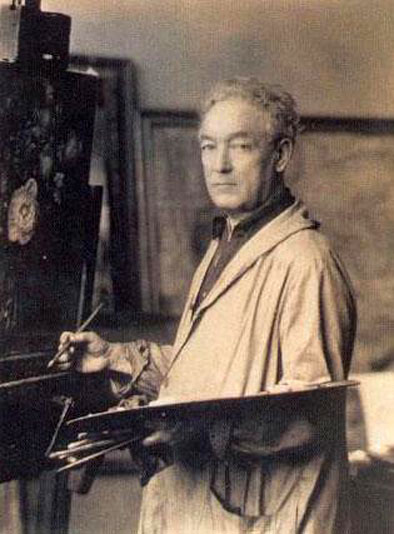
Photograph of William James Glackens
Glackens studied at the Pennsylvania Academy of the Fine Arts and later moved to New York City, where he co-founded what came to be called the Ashcan School art movement. This group of artists, dubbed by the press "the Eight Independent Painters" or The Eight chose to exhibit their works without pre-approval by the juries of the existing art establishment. He became known for his dark-hued paintings of street scenes and daily life in the city's neighborhoods. His later work was brighter in tone, and showed the influence of Renoir. During much of his career as a painter, Glackens also worked as an illustrator for newspapers and magazines in Philadelphia and New York City.
Glackens was born in Philadelphia, Pennsylvania, where his family had lived for many generations. His father Samuel worked for the Pennsylvania Railroad. William had two siblings-an older sister Ada, and an older brother, cartoonist and illustrator Louis Glackens. He graduated from Central High School in 1890. Throughout school he showed a great interest and aptitude for drawing and drafting.
Newspaper Illustration and Transition into Painting
After school Glackens became an artist-reporter for The Philadelphia Record. In 1892 he left that publication and began illustrating for the Philadelphia Press, where he covered various subjects. He then began taking evening classes at the Pennsylvania Academy of Fine Arts, studying under Thomas Anshutz. Glackens was not a steady pupil, as art critic Forbes Watson would observe in 1923: "So much impression did the various instructors make upon him that today he can hardly remember who taught there when he was a pupil." John Sloan also attended the Academy, and he introduced Glackens to Robert Henri. Henri began to arrange meetings at his studio to have discussions and give artistic criticism.
In 1895, Glackens traveled to Europe with several fellow painters, including Sloan and Henri. He first visited Holland where he studied the Dutch masters. They then moved to Paris where Glackens rented a studio for a year with Henri. Such a trip was common for artists of the time who wished to establish themselves in the art world. It was Glackens's first trip to Paris, but for the others it was a return trip. While in Paris, Glackens painted independently, but did not attend any schools. He returned to America in 1896 to work in New York. Later in his life, Glackens returned periodically to paint in Paris and the South of France.
Upon settling in New York in 1896, Glackens attained a job as an artist for the New York World. He got this position through his friend George Luks who was also an illustrator. Glackens soon became a sketch artist for the New York Herald. He also worked for various magazines as an illustrator.
In particular, Glackens illustrated for McClure's Magazine, which sent him to Cuba to make a series of drawings covering the Spanish-American War. When he returned, Glackens continued to illustrate for magazines, although his real passion was in painting. In 1901, he exhibited at the Allen Gallery with Henri and Sloan, and began to gain notice for his artwork.
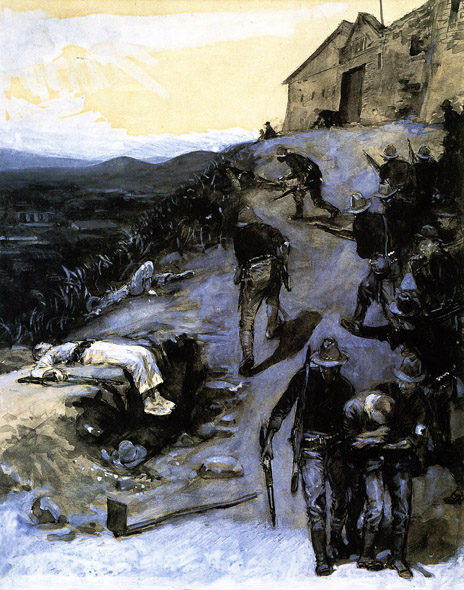
The Night after San Juan: 1898
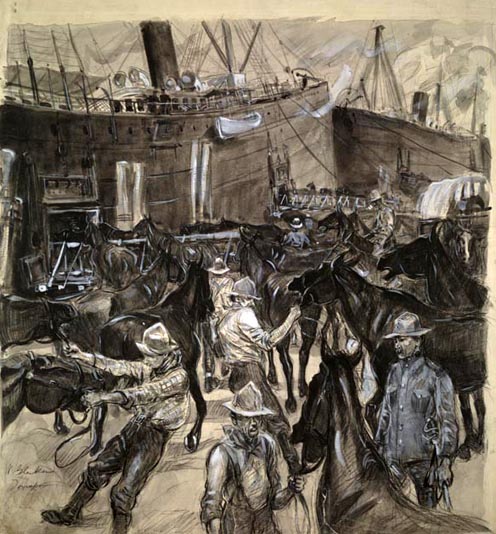
Loading Horses on the Transport at Port Tampa
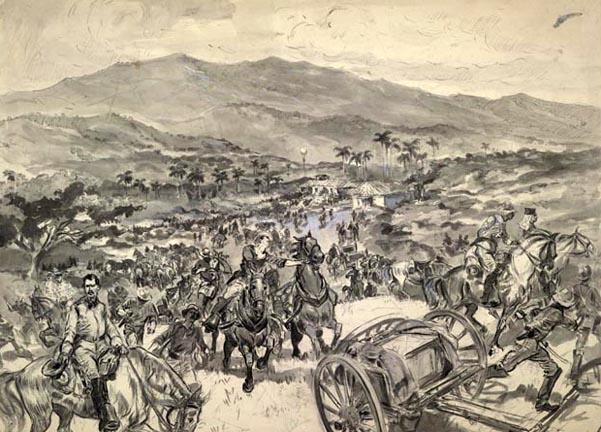
Just before El Poso: 1898
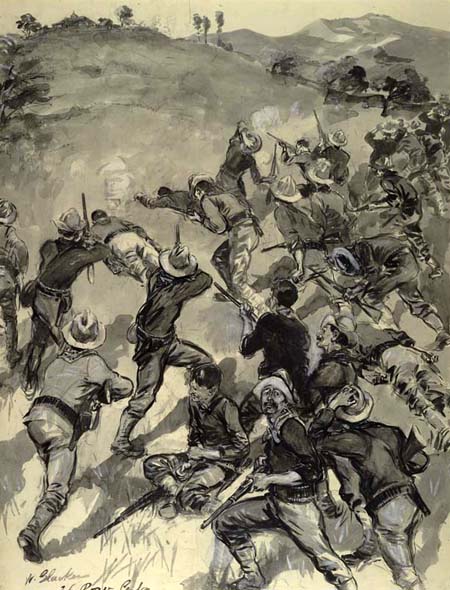
El Poso: 1898

Christmas Shoppers, Madison Square: 1912
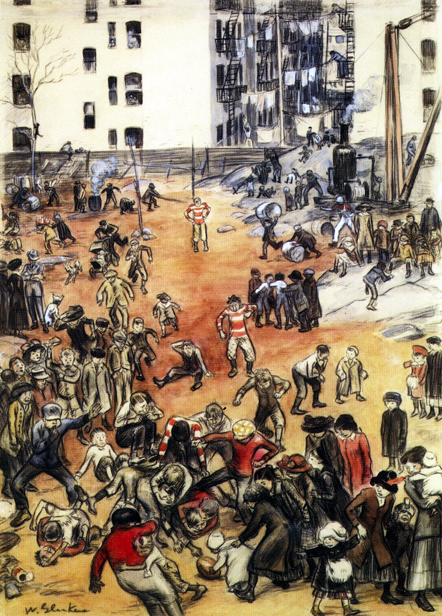
For the Championship of the Back Lot League: 1911
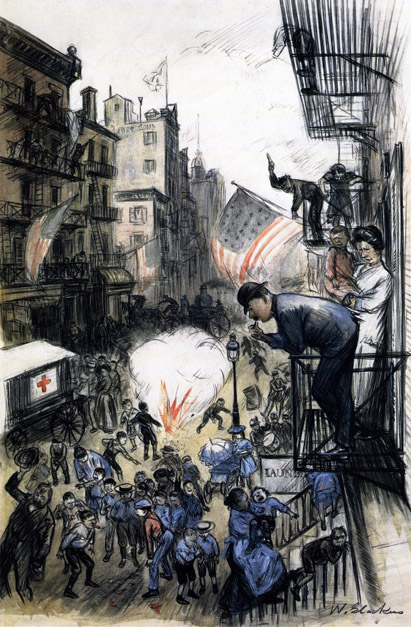
Patriots in the Making: 1907
Glackens married Edith Dimock in 1904. She was also an artist, and they lived together in New York.
Glackens and The Eight
Glackens soon began to associate with a group of artists now known as The Eight, or the Ashcan Group. They included Robert Henri, Arthur B. Davies, Maurice Prendergast, Ernest Lawson, William Glackens, Everett Shinn, John French Sloan, and George Luks. These men did not create the name themselves, but after their exhibition of 1908, it became their unofficial title. They decided to hold a separate exhibition after being continually rejected from the National Academy's events. It was a way to reject the controlling group's rigid definition of artistic beauty. Their exhibit was well received and was sent on tour as a traveling show curated by Sloan. They gained national recognition and were invited to exhibit at many institutions. Most of the Eight also participated in the "Exhibition of Independent Artists" in 1910, an attempt to break down the exclusivity of the academy.
The Eight are known for their realist style and are considered key figures in the realist movement. They depicted urban scenes and welcomed artistic freedom. Like Glackens, they were journalists, writers, or illustrators before becoming painters. They chose to continue with the style of illustration, which emphasized immediacy as well as community and interaction. Glackens was an integral part of the group. The "genre aspects" of Ashcan art are evident in his work of the time.
Glackens at Home
Artist and friend, Jerome Myers, recalls in his autobiography "Artist In Manhattan" his visits with Glackens: "The studio home of William Glackens, on Ninth Street just off Fifth Avenue, partook of the charm of this fine, boasted period. It was a delightful privilege for my wife and me to participate occasionally in the at-homes of the Glackens during the season. Surrounded by the masterpieces of William Glackens, friends would gather in congenial remembrance: Edith Glackens, always an amusing hostess; William Glackens, quietly reminiscing with his companions. The young Glackens, Lenna and Ira, filled out the family picture, happy with their young artist friends, as well as with older friends who had known them since childhood. Of the latter were Everett Shinn and Guy Pène du Bois; Wallace Morgan and Harry Dart, both of whom worked with me in the old New York Herald art department; May Wilson Preston, the Johansson's; and many other celebrities of New York's art life, reunited in informal pleasure, the whole scene imbued with the spirit of a New York that is now passing."
Later Work
By 1910 Glackens began to concentrate on a "highly personal coloristic style" instead of Ashcan ideas. His work was often compared to that of Renoir, to the point that he was called the "American Renoir". It is said that "although he identified with The Eight, who struggled to infuse a lusty spirit into a nearly moribund American art, it was for a brief time only, because his art could not develop within the limits of Ashcan philosophy." While Glackens continued to paint in a realist style emphasizing a single moment in time and real people, his art experienced a shift that distanced him from his Ashcan comrades.
About this time, Albert C. Barnes, a classmate and friend from high school, began to study and collect art. He commissioned Glackens to buy him some "modern" works while on a trip to Paris. These 20 paintings, which included works by Cézanne, Renoir, Manet, and Matisse, formed the core of what became the Barnes Foundation Collection. Glackens also advised Barnes on later art movements and purchases.
In 1916, Glackens served as the president of the newly founded Society of Independent Artists. He continued to travel to France between 1925 and 1935 to study the work of the Impressionists, the Post-Impressionists, and Les Nabis, the styles of which he adapted into his work. His paintings received gold medals from annual exhibitions at the Pennsylvania Academy of Fine Arts in 1933 and again in 1936.
Glackens died in Westport, Connecticut on May 22, 1938. His legacy is greatly linked to that of the Eight. Although having distanced himself from some of their ideals, he continued to be considered an integral part of the realist movement in American art.
Glackens's subject matter and style changed throughout his life. Influenced by the Impressionist work he saw during his stay in Europe, Glackens's early work uses "dark, dramatic colors applied vigorous in slashing brushstrokes." He depicted scenes of urban life in Paris and its suburbs. He continued this style and subject matter for some time until he began to break away from The Eight. At that point his most common subject matter was landscapes, especially beach scenes. Later Glackens became best known for his portraits, and late in his life he focused on still lifes. Despite the changing subject matter, Glackens's work always emphasized the reality of life and also the happiness. He "sought beauty and found it where conventional eyes saw ugliness." Watson asserts that Glackens focused on color because "the color of the world makes him thoroughly happy, and to express that happiness in color has become his first and most natural impulse." He painted because he wanted to show the beauty of the world. His paintings are "haunted by the spectre of happiness, obsessed with the contemplation of joy".
Glackens is often criticized for his similarity to Renoir. Some even call him an imitator. After the Exhibition of Independent Artists in 1910, Glackens's style shift was quickly compared to Renoir's style. It is said that during the 1920s and 1930s "his once vigorous artistic personality had been blunted by too close imitation of Renoir's late style." Glackens's interest in color likens him most to Renoir; Watson claims Glackens to have a "rich palette akin to Renoir's to express his pure delight in color."
Glackens is compared to Pascin because they were both "among the best illustrators of their day". They both used life for their subjects, and were able to see and emphasize the "humorous aspects" of life.
Nude with Apple is a signature piece of Glackens's career. It is said to be the turning point in his style and his division with The Eight. It is a portrait of a model resting on a couch, holding an apple. Critics have called it a "modern Eve" because of its reference to the fruit. The notable attention paid to bright, vivid colors sets this painting apart from those of The Eight.
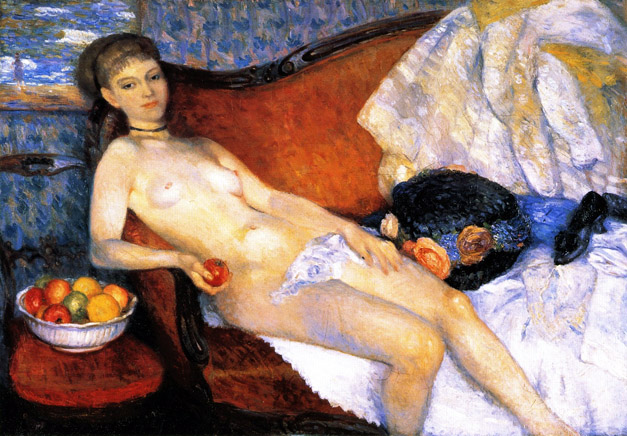
Nude with Apple: 1910
It is interesting to compare the finished work to an earlier study in pastel. Glackens's method of working would include numbers of sketches where he would focus on each element of the composition.
Chez Mouquin is arguably Glackens's most celebrated painting. It is set in the well-known restaurant regularly visited by many of Glackens' associates. The painting is a portrait of James B. Moore, a restaurant owner, who is depicted at a table with Jeanne Mouquin. He is drinking, while the lady is turned away looking uninterested. They are reflected in the mirror behind them, along with a large crowd of people in the room. The painting is often compared to those of Degas, but "the sense of despair in Degas's picture is replaced in the Glackens by a buoyant 'joie de vivre'." He portrays realist subject matter, the urban life, but does so with happiness and humor.
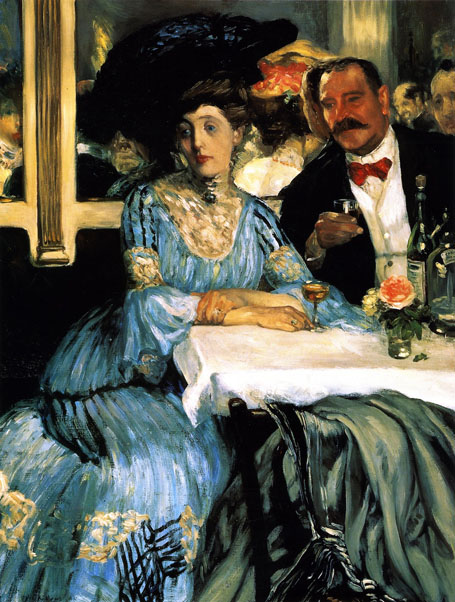
Chez Mouquin: 1905
In this vivid painting, William Glackens portrayed the members of his circle at their favorite meeting place, the restaurant Mouquin's in New York City. Jeanne Mouquin, the proprietor's wife, shares a drink with James B. Moore, a wealthy playboy and restaurateur, while the artist's wife, Edith, and art critic Charles Fitzgerald are reflected in the mirror behind them. Jeanne Mouquin is the focal point of the composition; not only did Glackens paint her outfit with eye-catching brushwork, but he also used the mystery of her intent gaze to imbue the work with tension. By combining portraiture and genre painting, the artist avoided clear narrative conventions and helped usher in a mode of painting suited to the uncertainties of modern urban life. However, the unusually candid depiction of drinking was criticized for its perceived impropriety.
Quoted From: At Mouquin's - The Art Institute of Chicago
Portrait of the Artist's Wife portrays Edith Glackens seated next to a fruit still life. It is one of many of Glackens's portraits. He also painted likenesses of several members of The Eight. The portrait does not idealize Edith. Rather he "frankly acknowledges her pert nose and small chin."
"I have found several paintings of the Artist's Wife but I remain unsure whether any of them is the portrait mentioned in this article". ~ Senex
Quoted From: William Glackens - Wikipedia
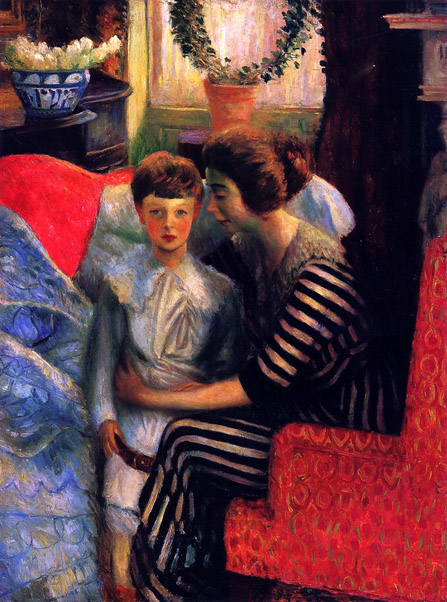
The Artist's Wife and Son: 1911
William J. Glackens, Painter: A Tribute to C. Richard Hilker, Patron; article by Dean Porter
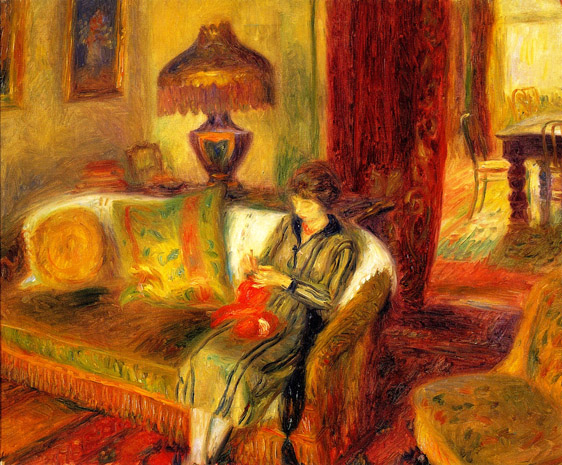
The Artist's Wife Knitting: ca 1920
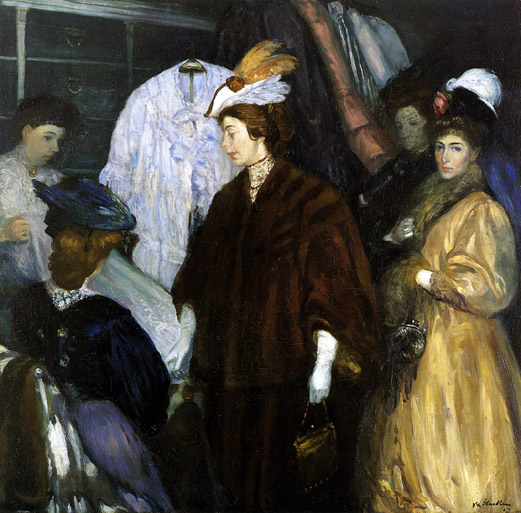
The Shoppers: 1907
This is a large square oil on canvas painting. It is an oil on canvas "genre" painting of middle-class New York life: it illustrates well-dressed women shopping for clothes. There are five women in the picture plane. The central woman, in a dark brown fur coat, with feathers in her hat, comes forward to the viewer with her left shoulder first, her face in profile. The woman in the foreground, in front of her, is seated with her back to the viewer. Two women are on either side of the furred woman and the last woman is nearly eclipsed in the background. The setting is a shop; behind the counter that the women face are drawers on the upper left and rolls of fabric on the right. The hanging white garment frames the central furred woman. The three principal figures are portraits: Edith Glackens is in the center, her companion at right is Mrs. Florence Shinn, and the woman seated at the left with her back to the viewer is Lillian E. Travis, known for her auburn hair.
Quoted From: Chrysler Museum Collection
Various Works of William James Glackens
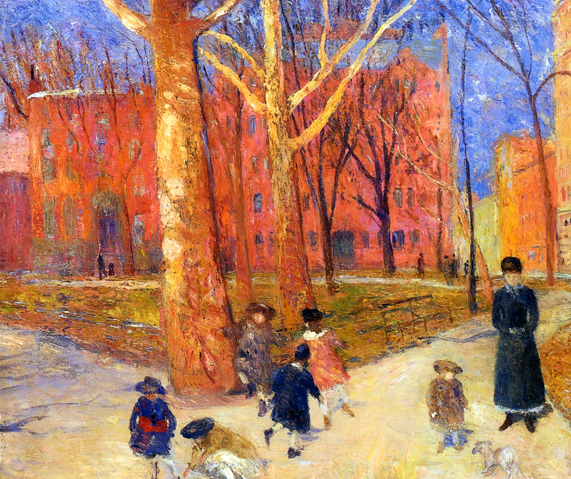
29 Washington Square: ca 1911-12
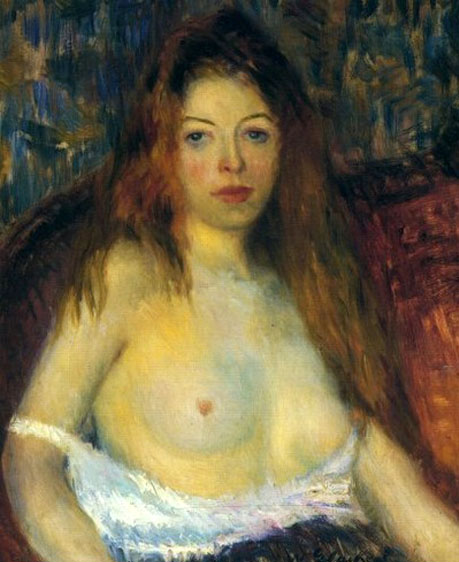
A Red Hair Model
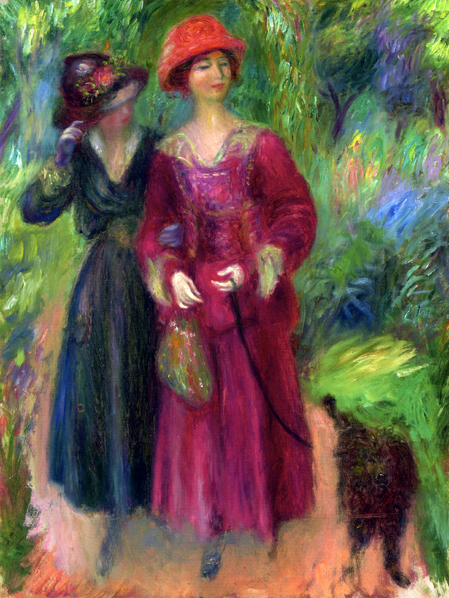
A Stroll in the Park: ca 1915-18
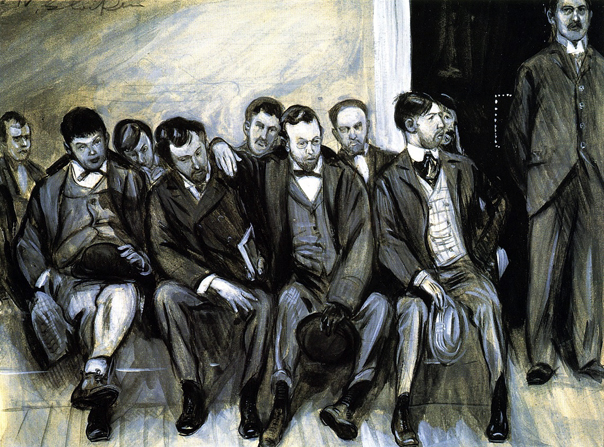
A Young Doctor, Especially during the Growth of his First Beard, Is Invariably a Music Lover: 1900
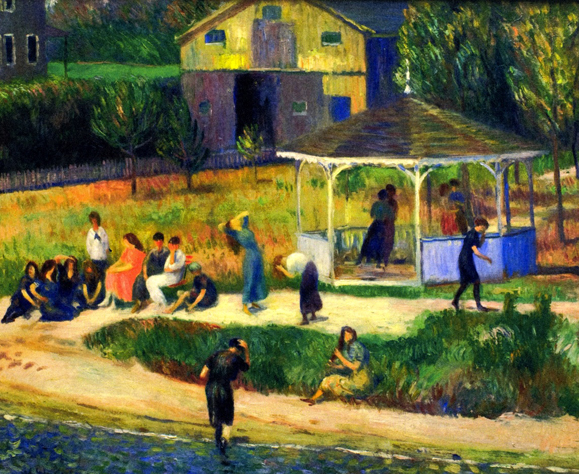
After Bathing, Vacation Home: 1913
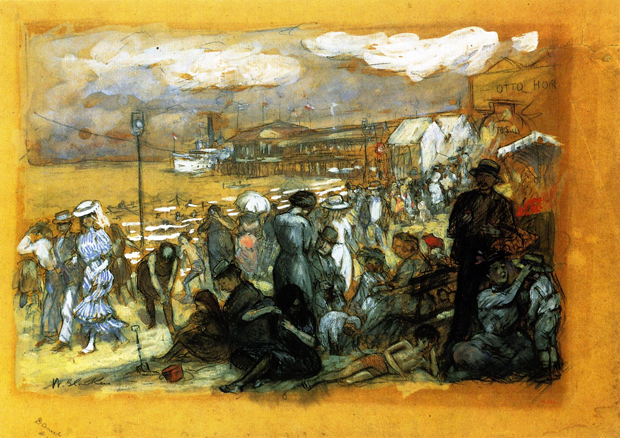
Afternoon at Coney Island: 1907
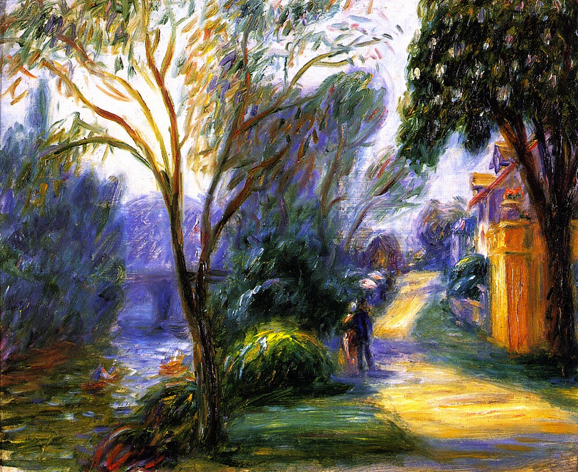
Along the Marne: Date Unknown

Apple Trees, Conway: Date Unknown
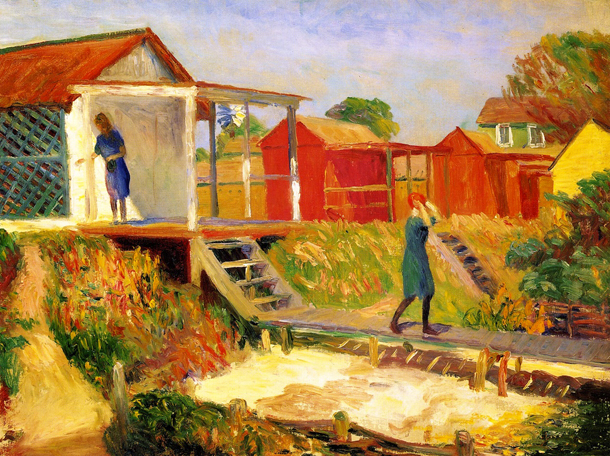
At the Beach, Bellport: ca 1910
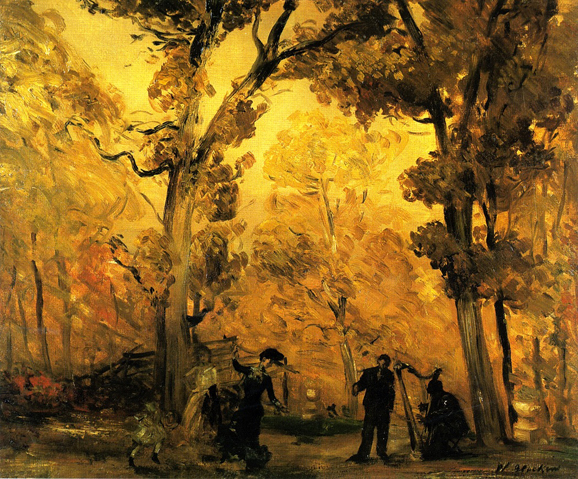
Autumn Landscape: ca 1893-95
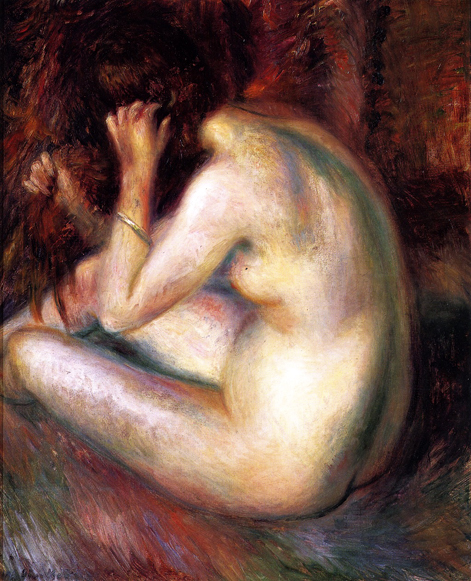
Back of Nude: ca 1930-38
_1934.jpg)
Baie Saint Paul, Quebec (No 2): 1934
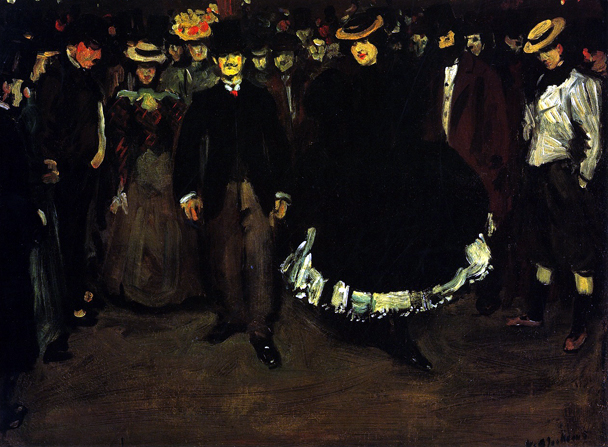
Bal Bullier: ca 1895
_1926.jpg)
Bal Martinique (study): 1926

Bathers, Bellport, No 1: 1913
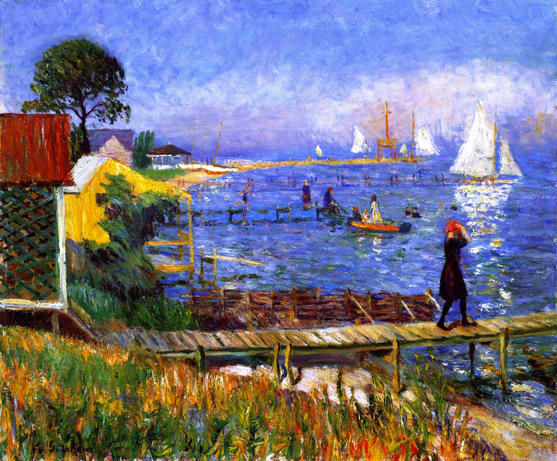
Bathers at Bellport: ca 1912
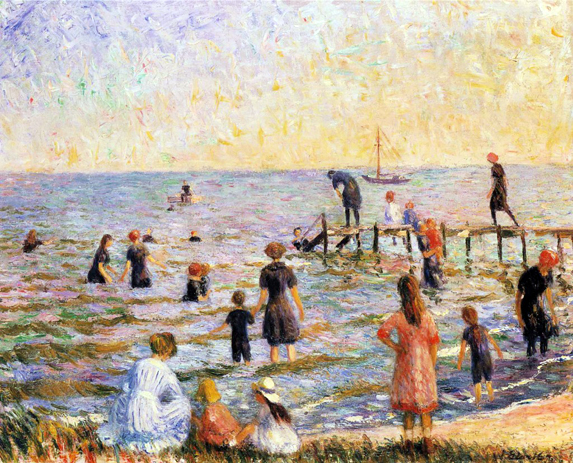
Bathing at Bellport, Long Island: 1911
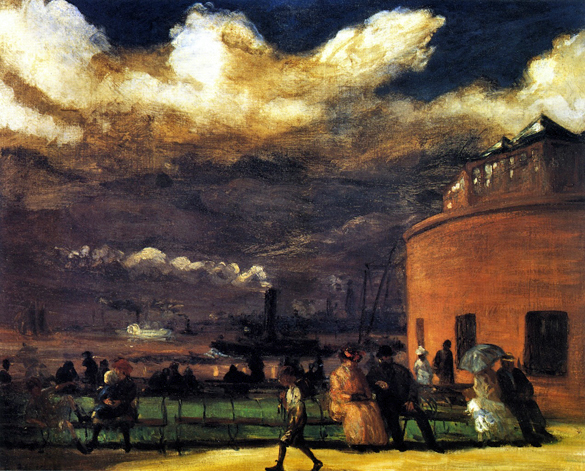
Battery Park: ca 1902-04
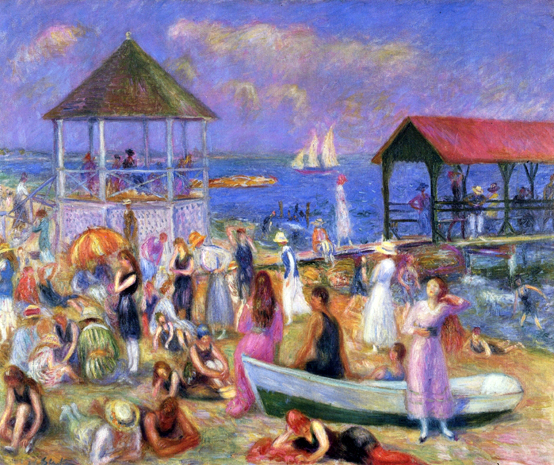
Beach Scene, New London: 1918
William Glackens was one of a group of New York painters of the early twentieth century who frequently painted scenes of the urban middle class at work and play. The festive, colorful seaside crowd was a favorite subject of the French Impressionists and was one Glackens often painted when he took his family to the public beach. Here, he used decorative color to convey the gaiety and squirming activity of a Connecticut beach. Glackens's brushstrokes are reminiscent of those of Renoir, and both painters portrayed the middle class with a romantic elegance and grace.
Quoted From: Beach Scene, New London - Columbus Museum of Art

Beach Scene: Date Unknown
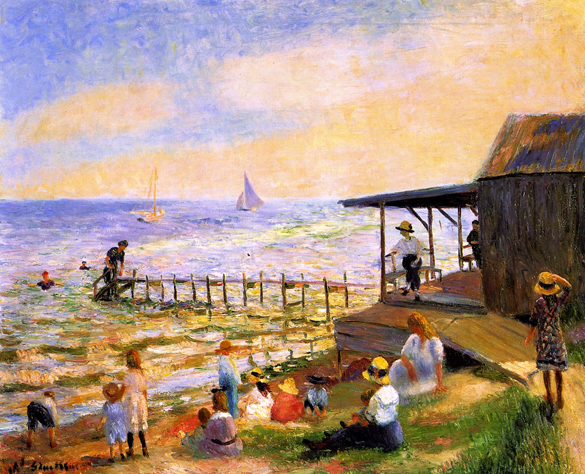
Beach Side: 1913
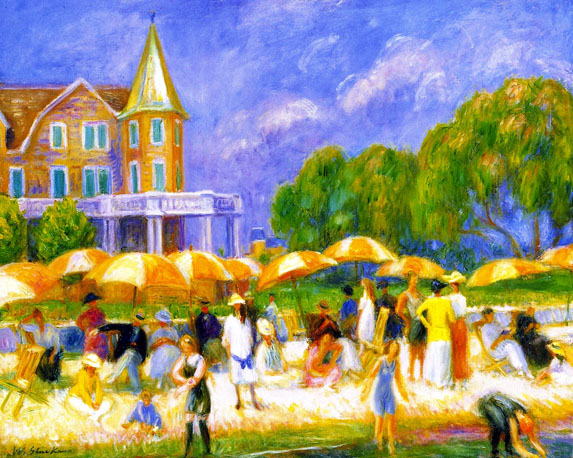
Beach Umbrellas at a Blue Point: 1916
Glackens's lively and colorful views of resort towns on the south shore of Long Island, New York, depict the leisure activities of a growing middle class in America—tourists who had the means to escape the heat of the city during the summertime.
Quoted From: Treasures to Go
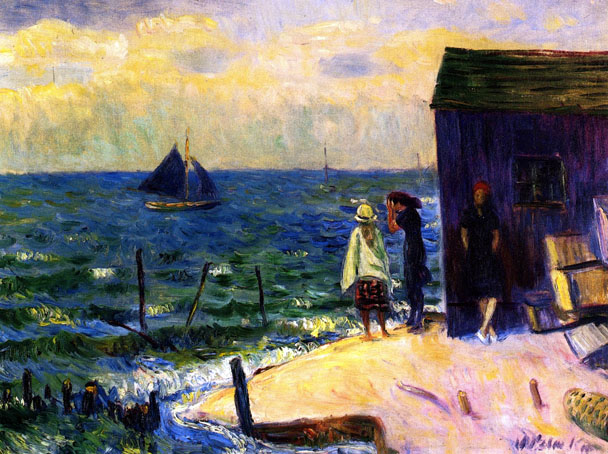
Bellport, Long Island: ca 1911-16

Bowlers, La Ciotat: 1930
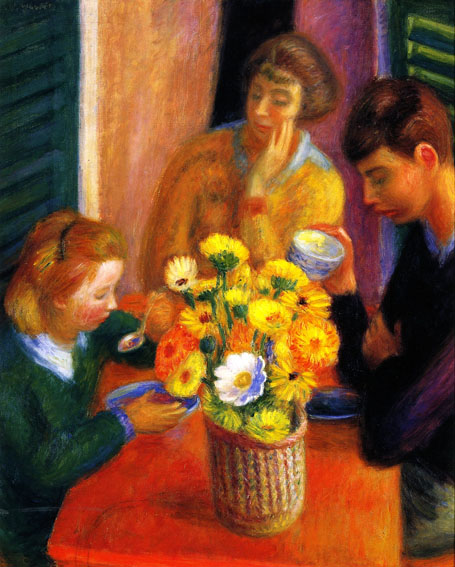
Breakfast Porch: 1925
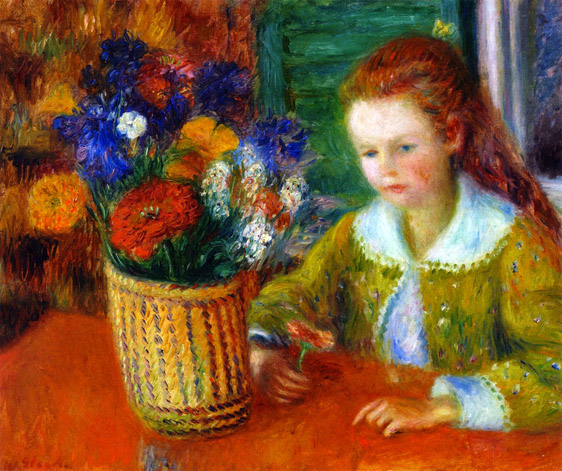
The Breakfast Porch: ca 1920
(Leena)

Breezy Day, Tugboats, New York Harbor: ca 1910
_ca_1916.jpg)
Buddha and the Maidens - (A Decoration): ca 1916
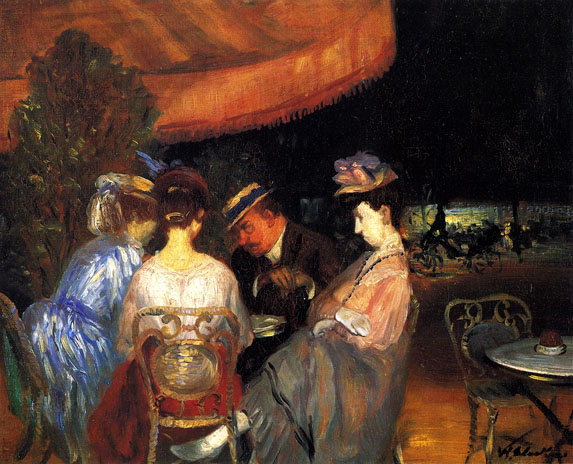
Cafe de la Paix: ca 1906
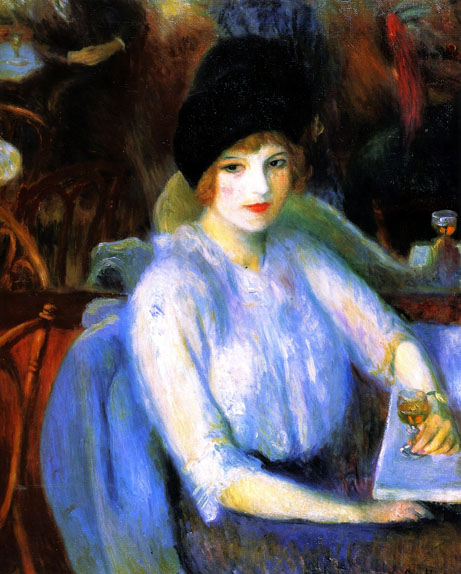
Cafe Lafayette: 1914
(Portrait of Kay Laurell)
Kay Laurell (1890 - 1927) was an American stage and silent film actress and model. Laurell began her career as an artists' model. After catching the eye of Florenz Ziegfeld, Jr., she was cast in the Ziegfeld Follies where she debuted in 1914. A popular performer who was noted for her beauty, she was called "one of the most beautiful women on the stage". In 1918, Laurell left the Follies to embark on an acting career. She went on to appear in stage productions on Broadway and in vaudeville, and made three silent films. In the 1920s, Laurel moved to Europe where she continued her stage career. She died during childbirth at the age of 36 in London.
She was born Ruth Leslie in 1890 (some sources state 1894) in Erie, Pennsylvania. She left Erie at the age of 16 to pursue a career in show business in New York City. After taking the stage name Kay Laurell, she worked as telephone operator and then found work as an artists' model. During her stint as a model, she posed for artists and illustrators including Howard Chandler Christy and William Glackens.
Quoted From: Kay Laurell - Wikipedia
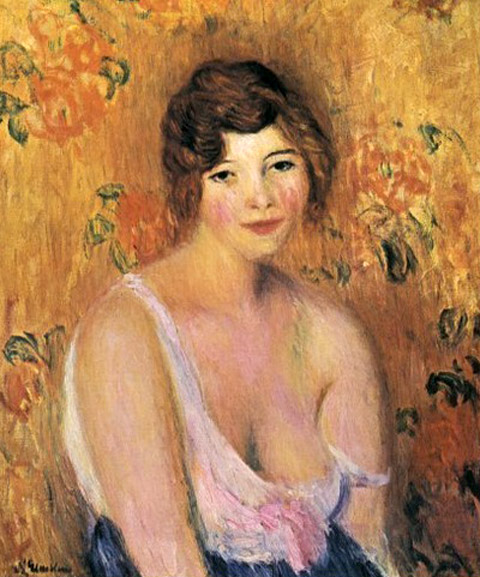
Portrait of Kay Laurell: 1915
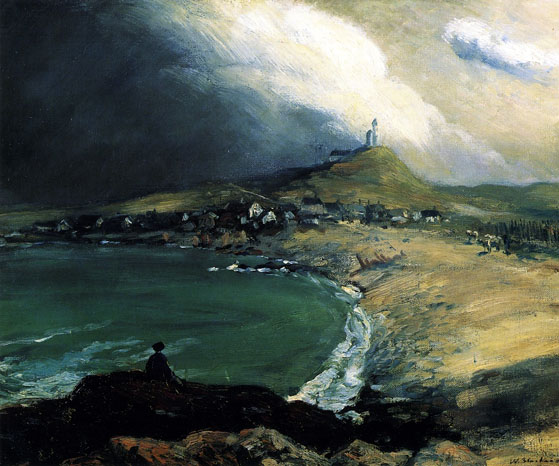
Cap Noir - Saint Pierre: 1903
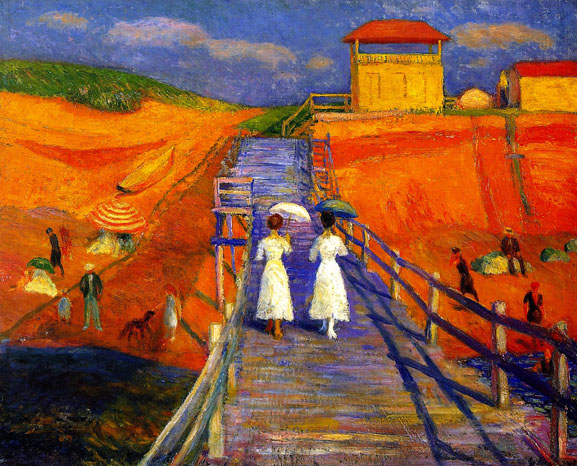
Cape Code Pier: 1908
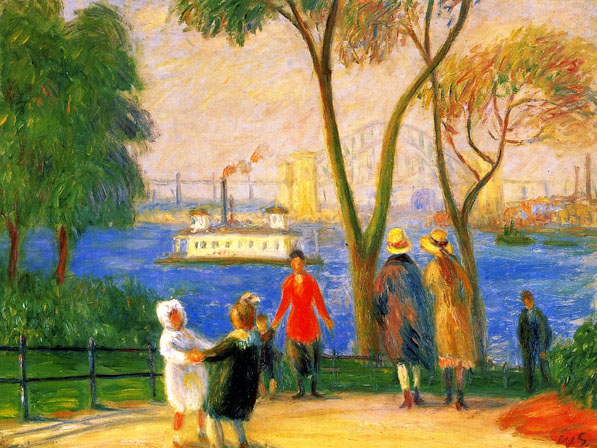
Carl Schurz Park, New York: ca 1922
The White House Historical Association - White House Collection
Scholar's Notes:
"Carl Schurz Park is located between 84th and 89th Street on the East River adjoining Gracie Mansion, the home of the mayor of New York. . . . By the time Glackens painted this scene, the park was no longer the center of an ethnic community but an urban oasis for a homogenized population. The view from the small park looks northeast over the broad expanse of the East River near its junction with the Harlem River. The confluence, called Hell Gate because of the dangerous currents, is traversed in this picture by a ferry seen at the left and by the Hell Gate Bridge (properly called the New York Connecting Railroad Bridge) just completed in 1917. In Glackens's rendering the great bridge is an insubstantial thing indeed, daintily sketched in pale blue with yellow ocher towers, scarcely more assertive than the pink, yellow, and blue sky or the candy-colored trees."
Quoted From: Asset Bank - Image Details, White House Collection
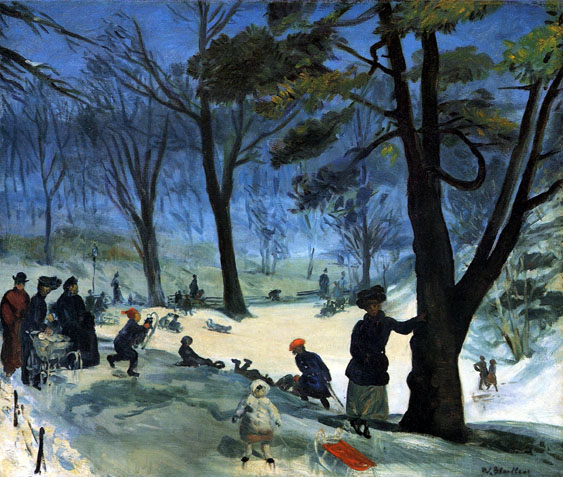
Central Park in Winter: ca 1905
Glackens portrays a group of well-behaved children sledding down a gentle slope in New York's Central Park under the watchful eyes of adults who dot the perimeter of a snowy knoll. The children are warmly dressed and the adults are fashionably clothed, signaling that this is a story of middle-class recreation. Despite their nominal commitment to telling the unvarnished truth about modern life and urban hardship, Glackens and other Ashcan artists viewed their world through rose-colored glasses, presenting the city euphemistically and, as here, depicting people at leisure in quasi-rural surroundings rather than in their overcrowded home neighborhoods.
Quoted From: Central Park, Winter - The Metropolitan Museum of Art

Chateau Thierry
Chateau-Thierry displays Glackens's personal variation on the French Impressionists' interests in color, atmosphere, and scenes of middle-class leisure. The painting resulted from a trip Glackens took to the village of Chateau-Thierry, located on the Marne River, while honeymooning in France. The man and woman in bathing costumes crossing the sunlit path in the middle ground are Glackens and his wife Edith, while the figure in red swim trunks who is about to dive into the water is Glackens's friend and fellow artist Alfred Maurer. Glackens's ability to capture the rich pageant of life along the river stemmed from his early career as a Philadelphia newspaper illustrator, which trained him to draw scenes quickly. Glackens made few changes when translating his small, lively sketch into the larger, finished painting. He removed a flagpole and flag that appear in the center of the sketch, perhaps thinking that they cluttered the composition.
Quoted From: The Huntington - eMuseum
_1906.jpg)
Chateau Thierry (Study): 1906
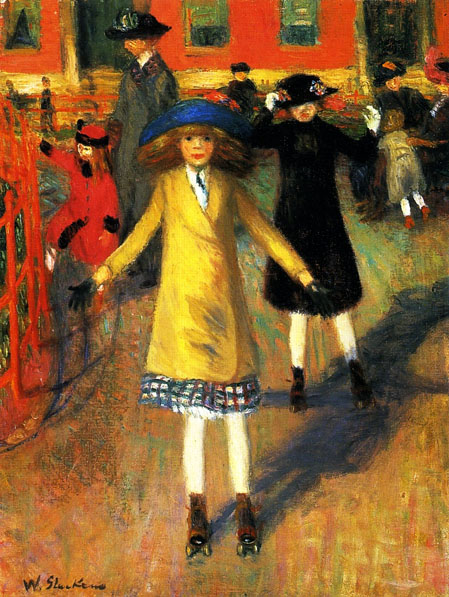
Children Roller Skating: ca 1918-21
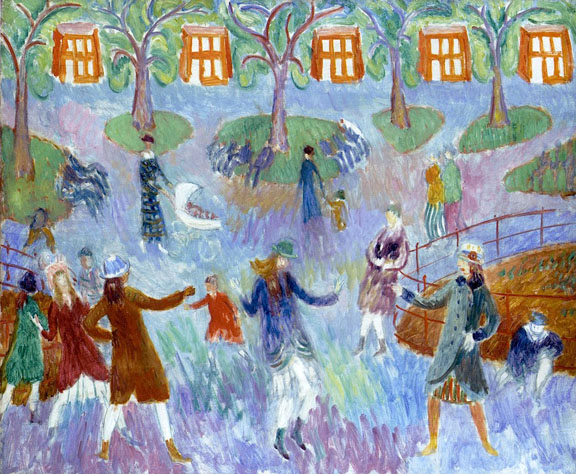
Children - Washington Square Park: Date Unknown
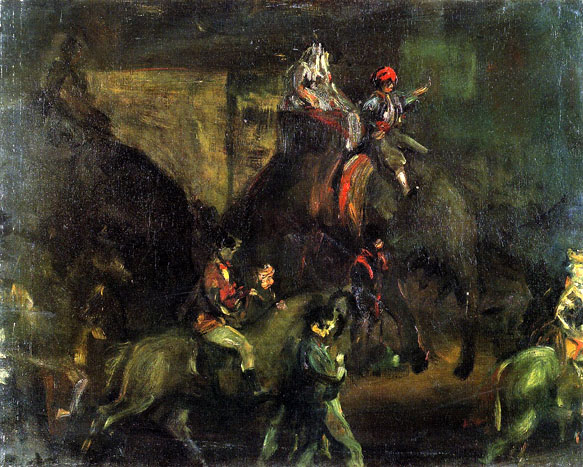
Circus Parade: ca 1895
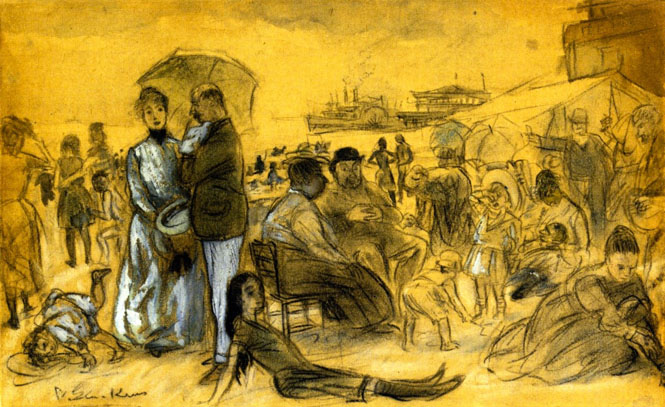
Coney Island: ca 1910

The Conservatory: ca 1917
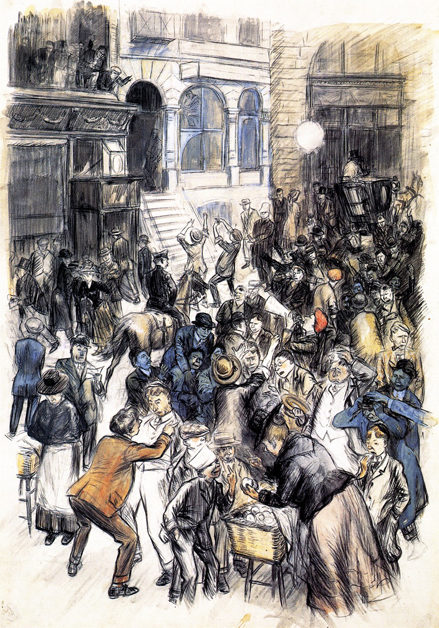
Curb Exchange No 3: ca 1907-10

Dancer in Blue: ca 1905
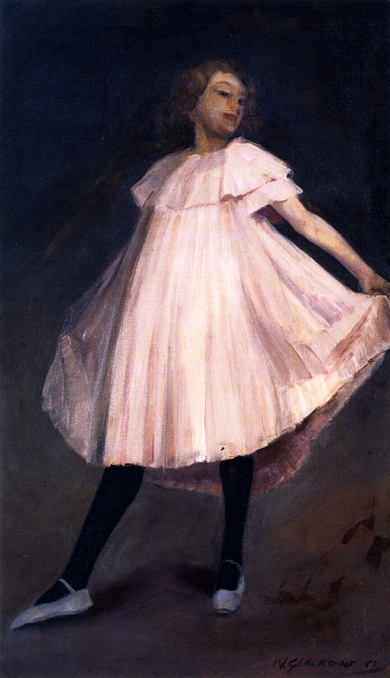
Dancer in Pink Dress: 1902
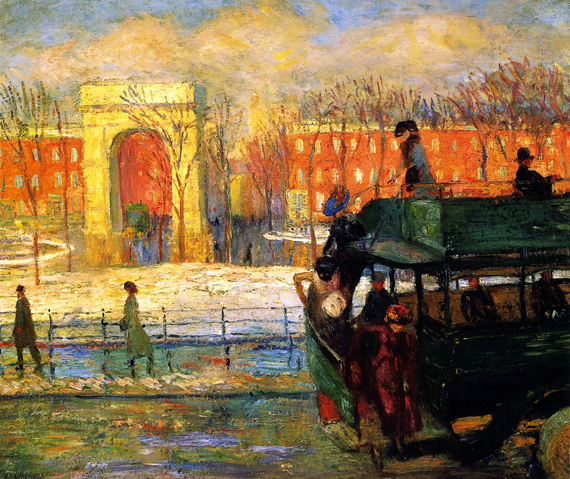
Descending from the Bus: ca 1910

The Dream Ride: 1923

The Drive - Central Park: 1905
Unlike most other Ashcan painters, William Glackens adopted the outlook of the French Impressionists. This painting combines brisk brushwork with intense color to suggest the pleasure of a Sunday promenade in New York City's Central Park. The attention to certain details, like the top hats and parasols, further describes the lifestyle enjoyed by New York's upper classes. Trained as a newspaper illustrator in Philadelphia before moving to New York, Glackens also traveled to Europe, where he was influenced by the vigorous brushwork and realistic subject matter of 17th-century painters, including Rembrandt van Rijn, Franz Hals, and Diego Velazquez.
Quoted From: The Drive, Central Park - Cleveland Museum of Art
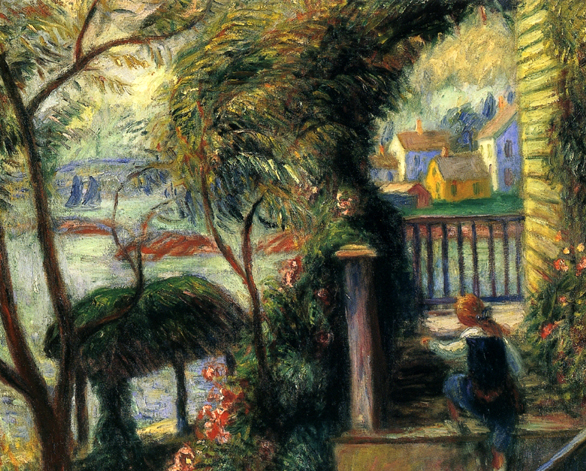
East Point, Gloucester: 1919

East River from Brooklyn: 1902
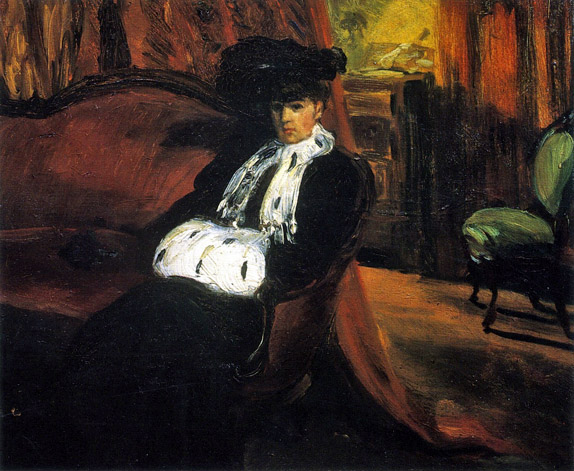
The Ermine Muff: ca 1903

Ernest Lawson: 1910
Lawson provided the Academy with a progress report on his diploma portrait in a letter of April 13, 1910: "Glackens had only a few touches to do on the portrait but yesterday he got it in a bad state and he couldn't finish it. So I can't send it up today as I said. I'll send it as soon as it is done. I pose again tomorrow. I never knew [my] mug was so hard to get."
Quoted From: Collections - National Academy Museum

Factory Scene: ca 1895
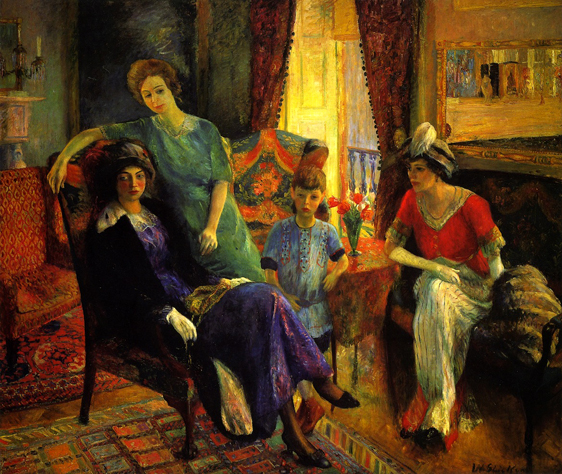
Family Group: 1910-11
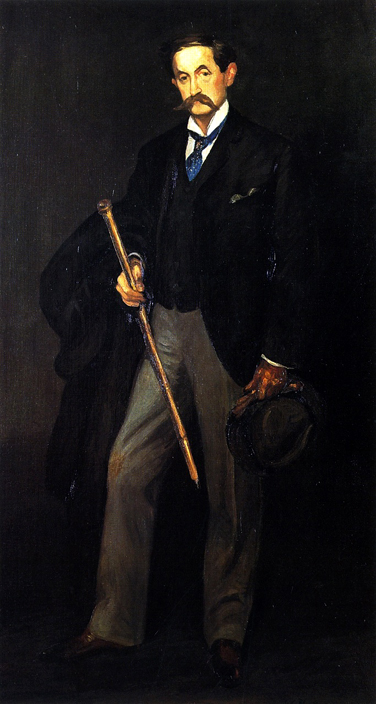
Ferdinand Sinzig
aka Portrait of a Muscian: ca 1906
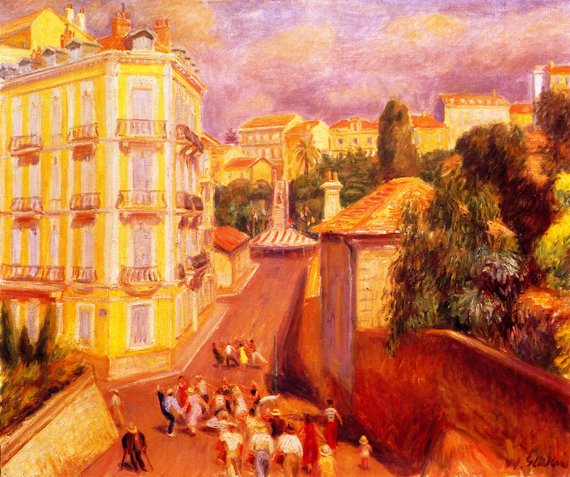
Fete du Suquet: 1932
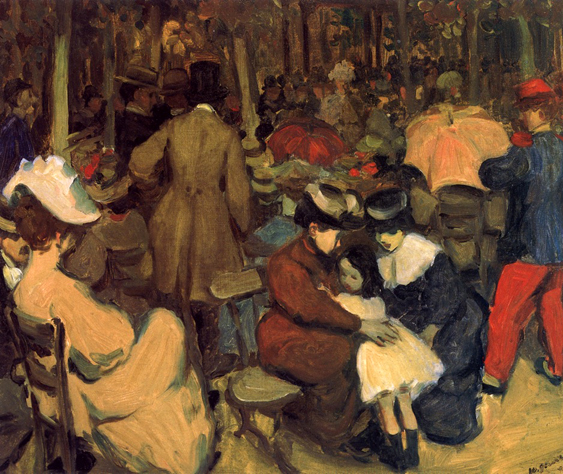
Figures in a Park, Paris: 1895

Flowers Against a Palm Leaf Pettern: ca 1920
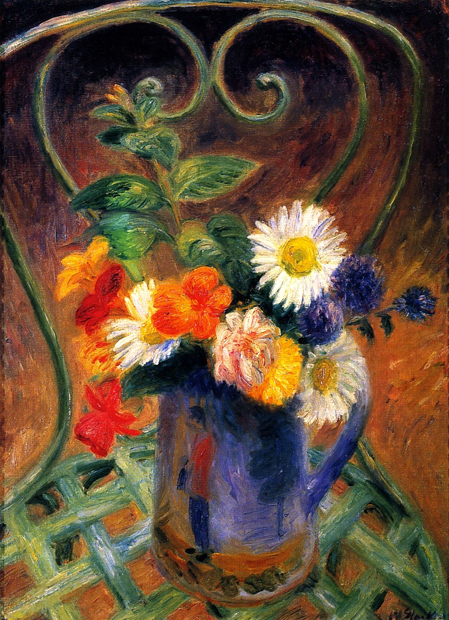
Flowers in a Garden Chair: 1925

Flowers in a Quimper Pitcher: ca 1930

Flowers on a Garden Chair: Date Unknown
_1906.jpg)
Flying Kites, Montmartre (Study): 1906
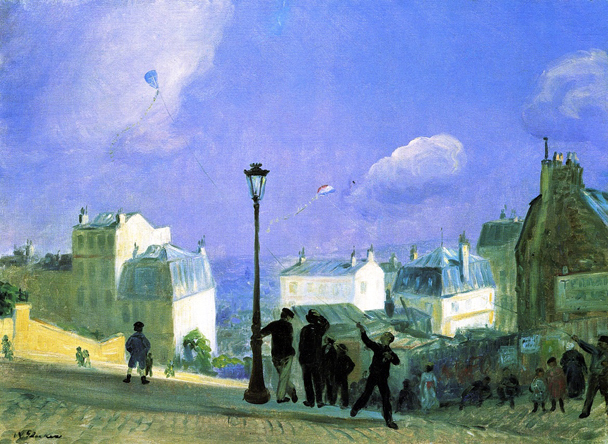
Flying Kites, Montmartre: 1906
In his biography of his father, Ira Glackens described William Glackens's attraction to France: "Paris was always my father's favorite city, and France his spiritual home. Everything suited him there, the food, the wine, the people in the streets and public gardens, whom he loved to sketch; the look of restaurants, shops, and cafés; the color of the houses, the signs, the trees, the rivers, the fishermen, the villages, the flow of life. No other country seemed so to invite his pencil and his brush." (Ira Glackens, "William Glackens and the Ashcan Group," New York: Grosset & Dunlap, 1957, p. 69). Glackens first traveled to France in 1895 with his friend Robert Henri, the leader of the Ashcan school, and remained there for fifteen months, based in Paris, with occasional trips to northern France, Belgium, and the Netherlands. Thereafter, Glackens returned periodically to France, and from 1925 until 1932, he would spend part of every year there.
Quoted From: Flying Kites, Montmartre - Museum of Fine Arts, Boston

From Under Willows: ca 1914
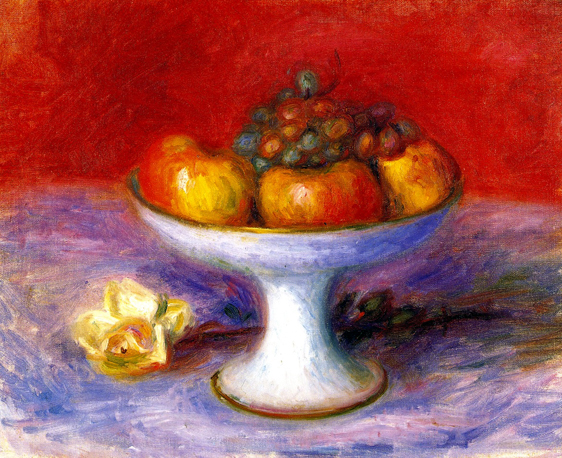
Fruit and a White Rose: ca 1930-39
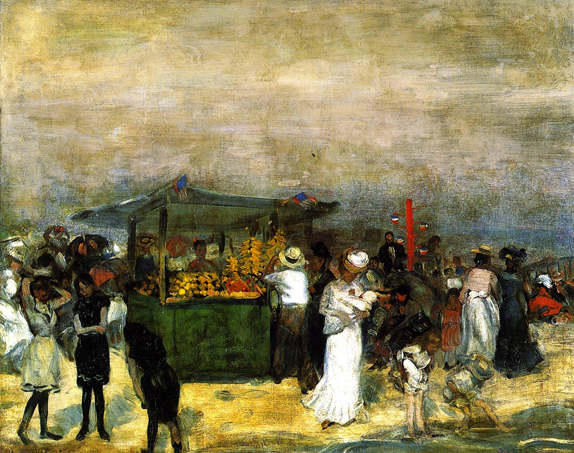
Fruit Stand, Coney Island: ca 1898
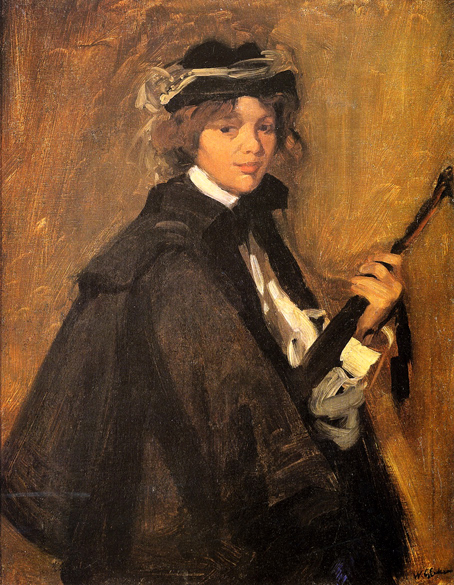
Girl in Black Cape: ca 1897
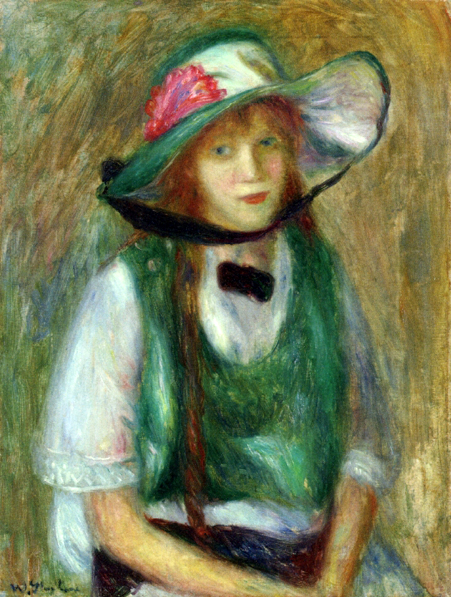
Girl in Green: Date Unknown
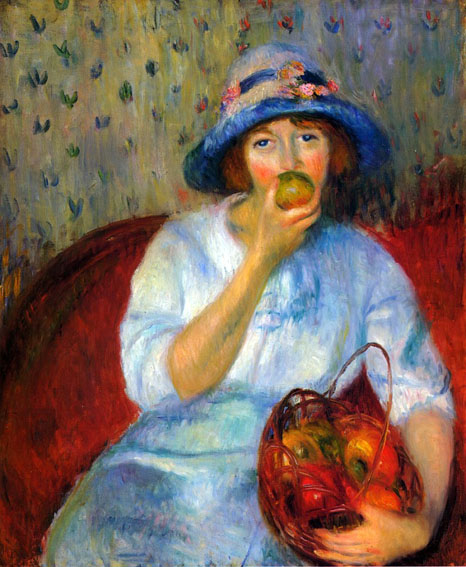
Girl with Green Apples: ca 1911

Girl with Apple: ca 1909-10
For William Glackens, who began his career as a quick-sketch newspaper illustrator, drawing was a nearly automatic activity, rapidly executed and broadly suggestive. For a large and ambitious studio nude such as Girl with Apple, he completed numerous preparatory sketches. Before executing this relatively "finished" version in pastel, Glackens made pencil sketches, which are scribbly in character. They demonstrate his method of working out a pose by drawing limbs in a sequence of positions on the same sheet, creating an almost cinematic effect. By this stage, he had firmly established the placement of pictorial elements and begun to finalize his palette in pastel. Although Glackens often made significant changes to his compositions in the painting phase, his unwillingness to leave anything about this work to chance suggests the impact he sought for its exhibition debut.
Quoted From: Brooklyn Museum: American Art: Girl with Apple
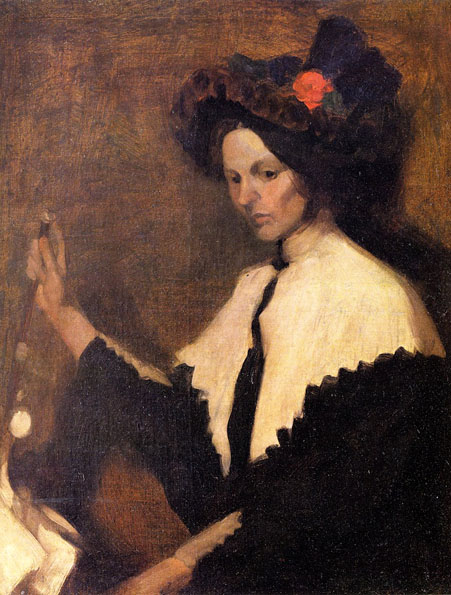
Girl with White Shawl Collar: ca 1894
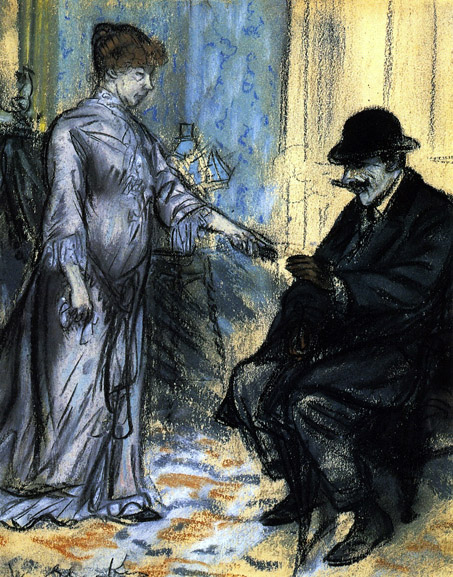
Graft: 1903
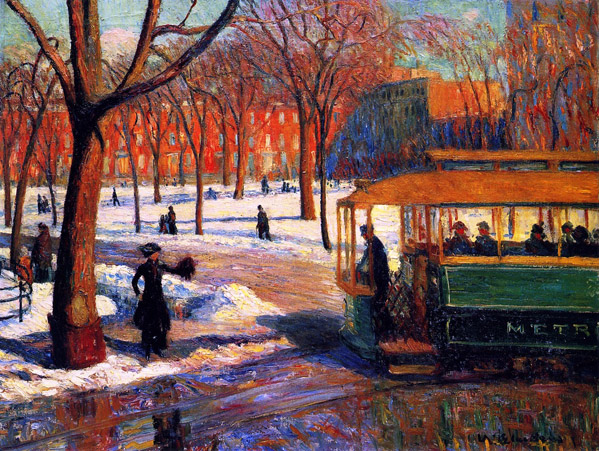
The Green Car: 1910
William Glackens was a keen observer and able recorder of the rhythm and details that comprised daily life for urban dwellers in early twentieth-century America. As a young man he earned a living as an artist-reporter for several newspapers and magazines, first in his native Philadelphia, then in his adopted home of New York after 1896. His recording of the episodic drama of everyday occurrences served him well in his other career as a painter, in which he was able to capture the smallest details of gesture and incident, thus endowing his canvases with a sense of spontaneity and life.
In his early years in Philadelphia, Glackens came into contact with some of the artists who, with him, became known as The Eight, later called the Ashcan School: Robert Henri, John Sloan, Everett Shinn, George Luks, Ernest Lawson, Maurice Prendergast, and Arthur B. Davis. He gained recognition for his paintings in The Eight's only exhibition, held at the Macbeth Gallery in Manhattan in 1908. The group shocked the art establishment with its preference for painting contemporary urban scenes in a forthright manner, rather than traditional academic subject matter. Of all the members, Glackens was most obviously influenced by Impressionist paintings, which he had seen during trips to France in 1895-96 and 1906, particularly the feathery brushwork and high-keyed palette of Pierre-Auguste Renoir.
Glackens had a studio on Washington Square Park in New York City's bohemian Greenwich Village, from which he painted "The Green Car." In this picture, a green trolley car rounds the corner at the south side of the park on its way to pick up a lady standing by the snowy curb. Dressed smartly in a long coat, hat, and muff, she signals to the conductor. In viewing this carefully structured composition, our eye moves from front to back, following the route of the trolley and the converging pathways through the park until we reach the row of three-story brick buildings in the background. The overall effect of the picture is one of energy and movement enhanced by the consistently animated brushwork and bright mix of colors used throughout the composition.
Quoted From: The Metropolitan Museum of Art - The Green Car
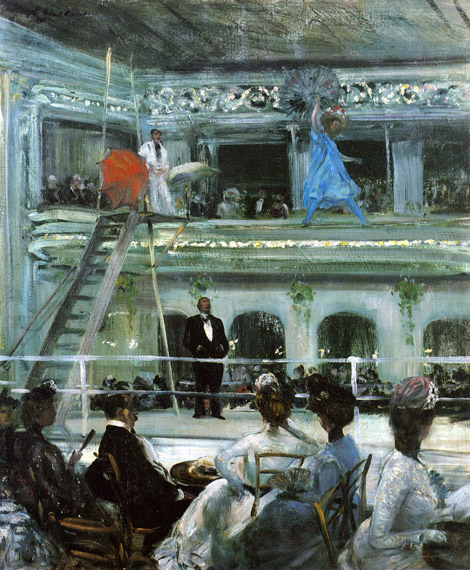
Hammersteins Roof Garden: ca 1901

The Hammock: ca 1919

Home in New Hampshire: ca 1919

In the Buen Retiro: 1906
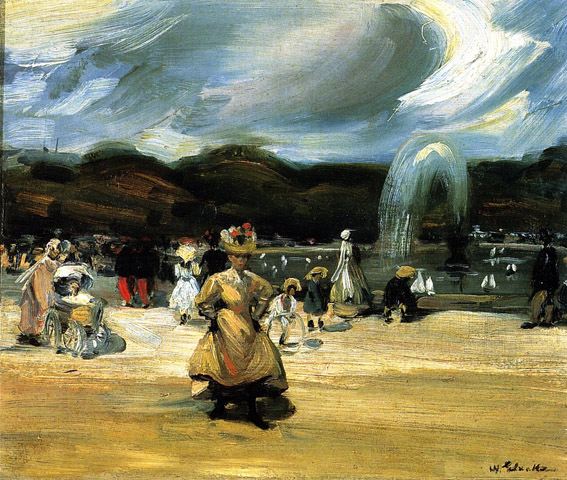
In the Luxembourg: ca 1896
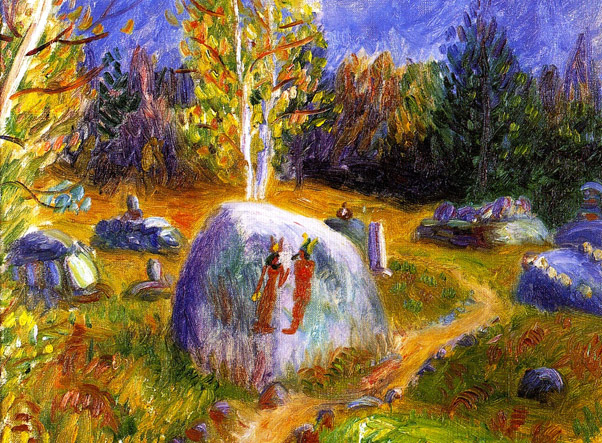
Ira and Lenna's Egyptian Burial Ground: 1923
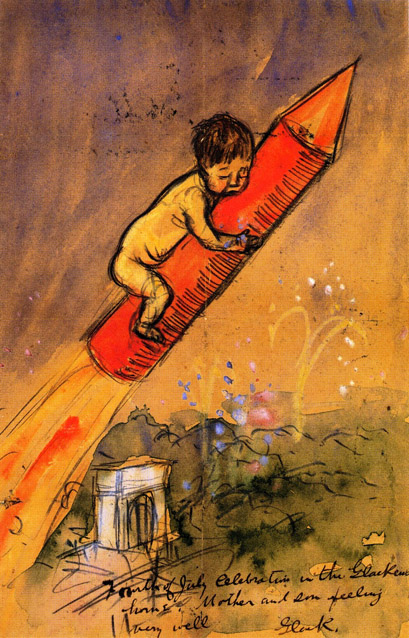
Ira on a Rocket: 1907
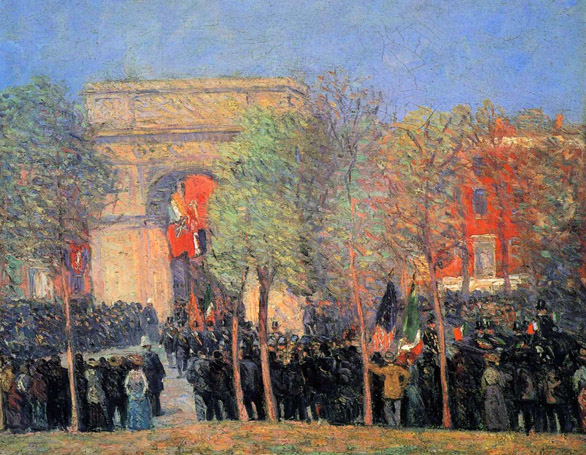
Italo-American Celebration, Washington Square: ca 1912
When Glackens painted this scene of the parade celebrating Christopher Columbus's discovery of America, Italian-Americans formed the largest immigrant population in Manhattan. Columbus became a role model for many ethnic and religious groups, and Glackens suggests the international flavor of the celebration by painting a variety of flags visible through Washington Square Arch. The juxtaposition of the Old World and the New is further enhanced by the prominence of the Italian and American flags standing side by side in the lower foreground. The American dream of rapid transformation from immigrant to respected community leader is suggested by the modestly dressed onlookers who observe both the decorated men in top hats seated under the arch and those successful citizens spirited away above the throng in a carriage. Rendered with lively brushwork to enhance the festive and breezy atmosphere, the composition presents a distinctly American spectacle of Italian-American revelers and their pride of place in the urban scene.
Quoted From: Italo-American Celebration, Washington Square - Museum of Fine Arts, Boston

Julia's Sister: ca 1915
William Glackens de-materializes the presence of the young woman in Julia's Sister by surrounding her with colorful palette of aquatic greens and blazing oranges that is joyful but at odds with her passive expression. The bouquet of flowers over the girl's right shoulder, the ring of flowers around the brim of her hat, and the indistinct patterning of the wall around her, all position the sitter as the centerpiece of a complex floral arrangement. In the thin paint application, a few swirls of pigment, particularly in the flowers depicted, register the fluid strokes of his brush, imbuing the work with a measure of texture and tactility.
Quoted From: The Eight and American Modernisms
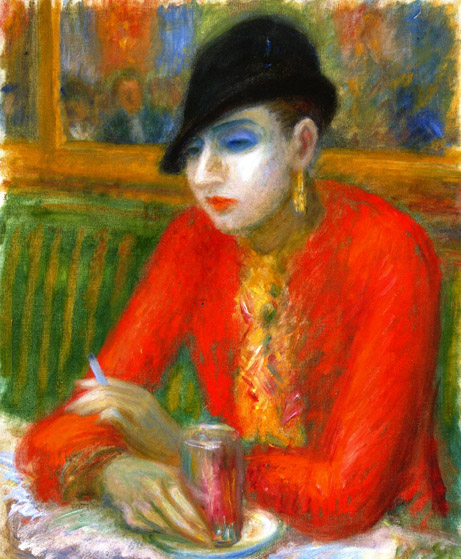
L' Apertif: 1926
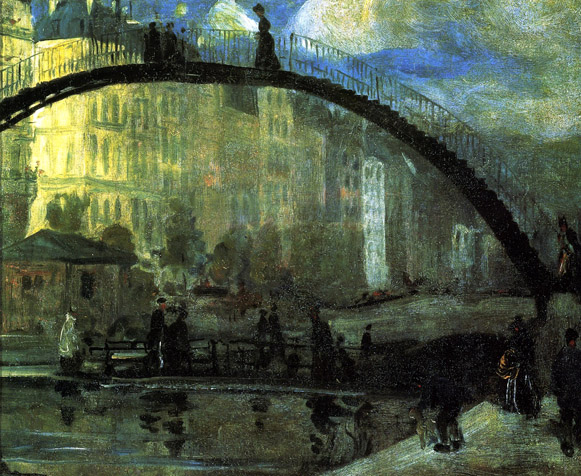
La Villette: 1895
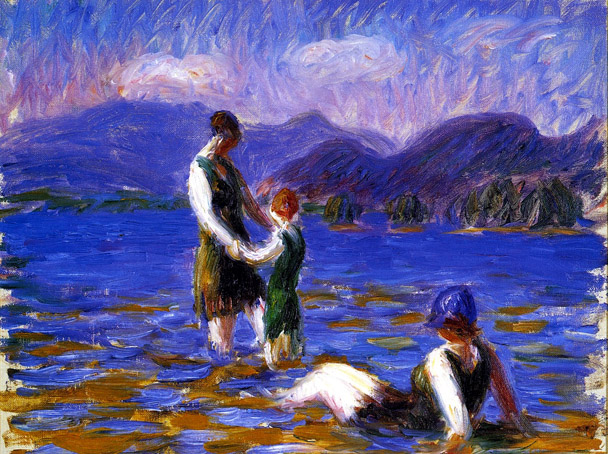
Lake Bathers: ca 1920
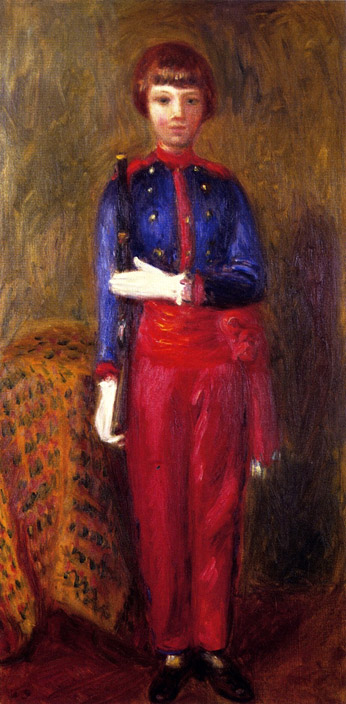
Lenna as Toy Soldier: ca 1923

Lenna at One Year: 1914

Lenna Painting: 1918
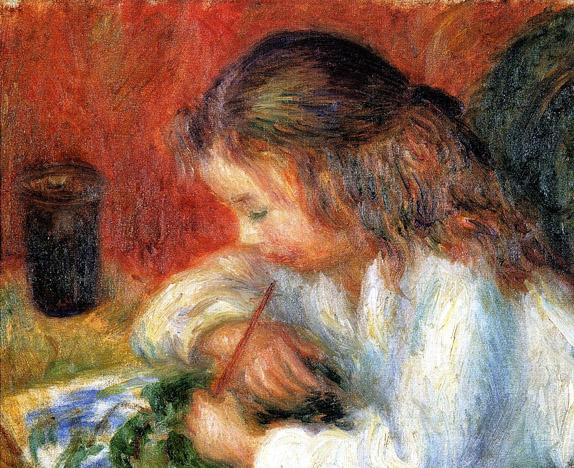
Lenna Painting: ca 1918
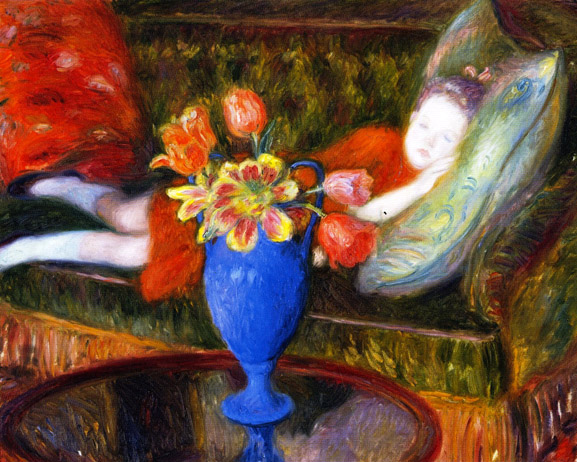
Lenna Resting: ca 192
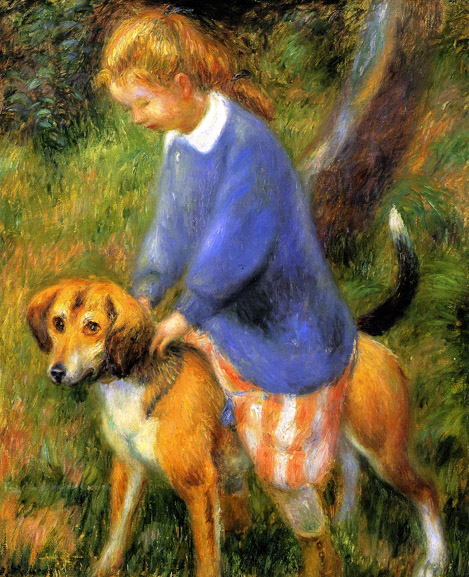
Lenna with Rabbit Hound: ca 1922

Little May Day Procession: ca 1905
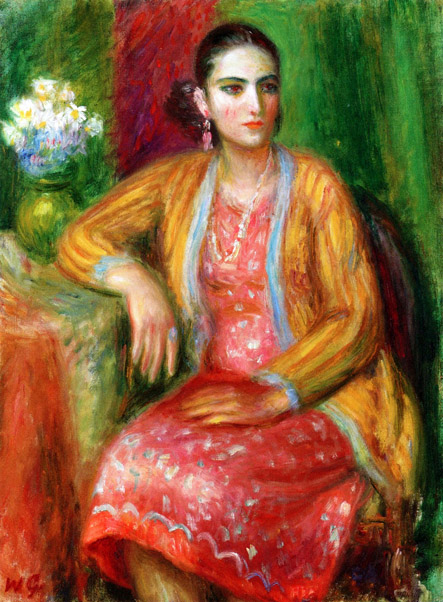
Luisa in a Pink Dress: Date Unknown
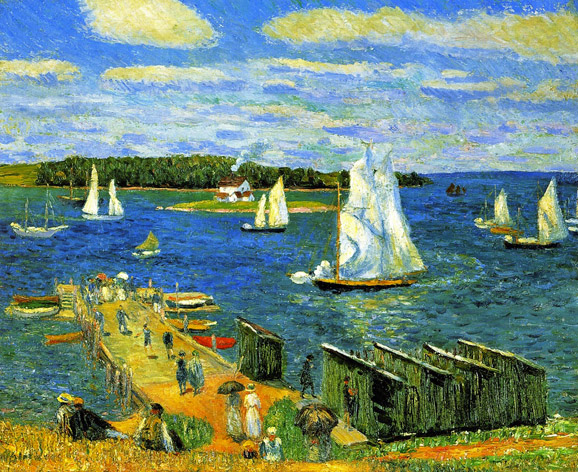
Mahone Bay: 1911
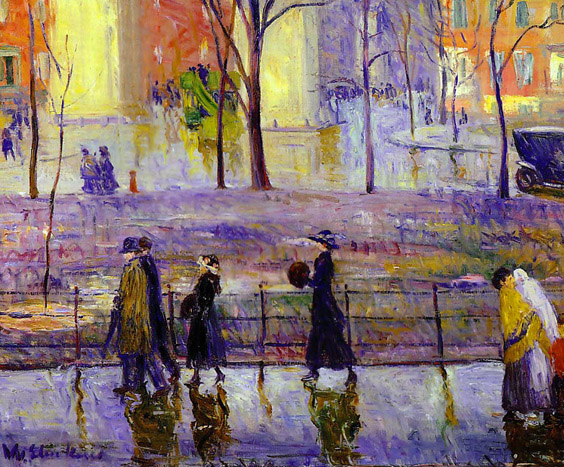
March Day, Washington Square: ca 1912
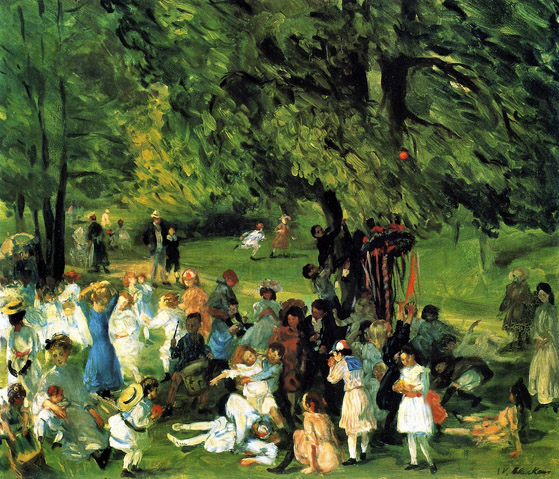
May Day in Central Park: ca 1905
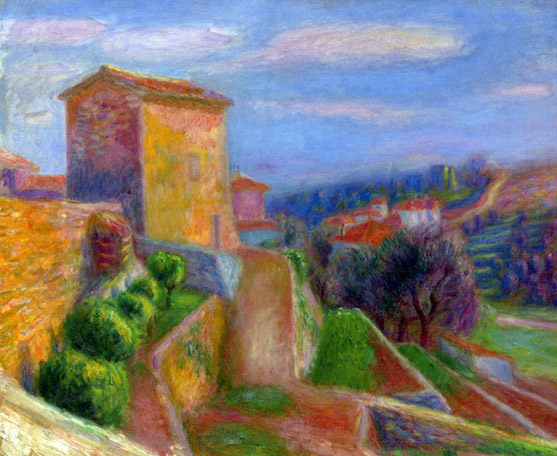
Midi Terrace: ca 1925-32
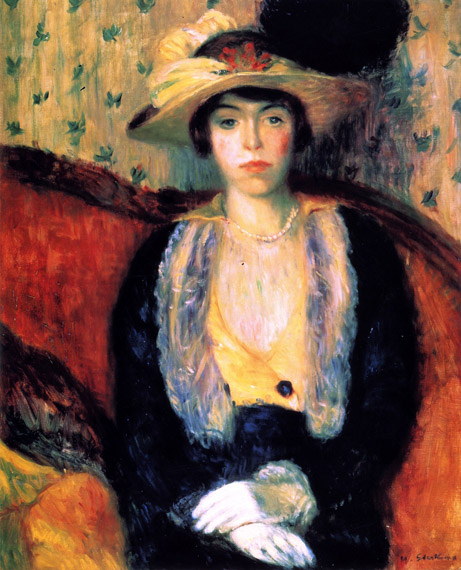
Miss Olga D: 1910
Recent research into William Glackens' "models" notebooks reveals that Miss Olga D was probably Olga Dazell. This painting was one of the first of many images of professional models by the artist. Ira Glackens, the artist's son, recalled, rather cynically, that "Father was always prone to hire models who needed a job, and that is why so many of his canvases were of exceedingly plain females, though paintable."
Quoted From: Hunter Museum of American Art - Miss Olga D
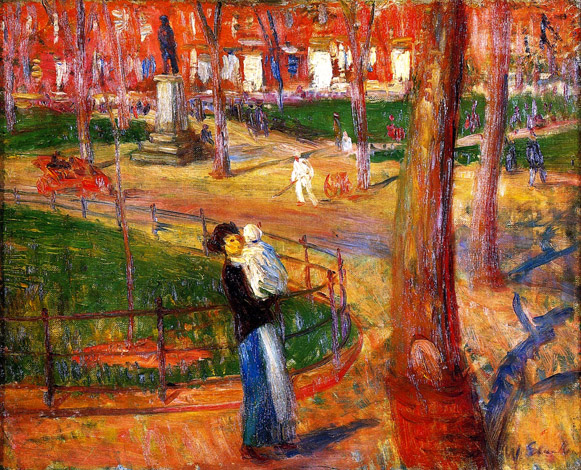
Mother and Baby, Washington Square: 1914
_ca_1918.jpg)
Music Hall Turn (study): ca 1918

Nasturtiums in a Glass Vase: Date Unknown
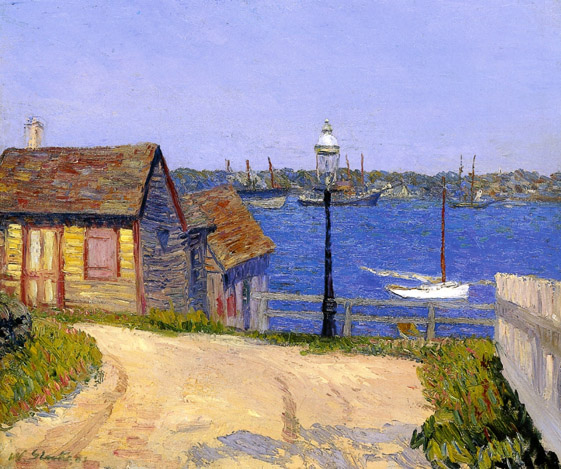
New Castle, New Hampshire: 1909

North Beach Swimming Pool: 1916
_Date_Unknown.jpg)
Nude in Green Chair (unfinished): Date Unknown
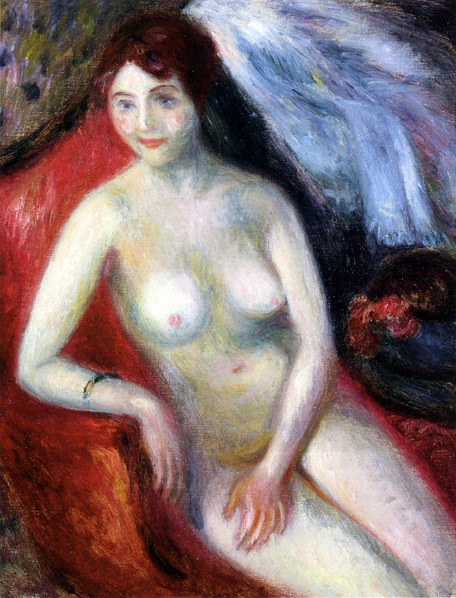
Nude on a Red Sofa: ca 1910
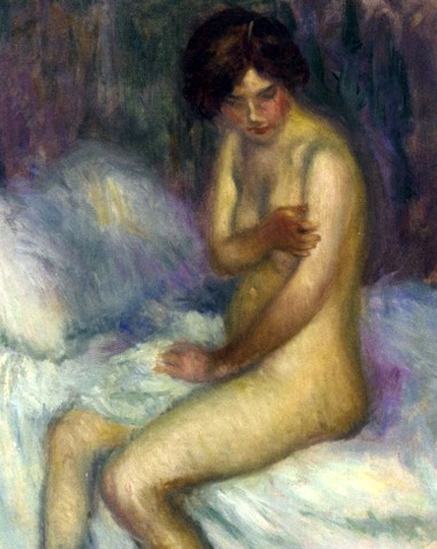
Nude Sitting on a Bed
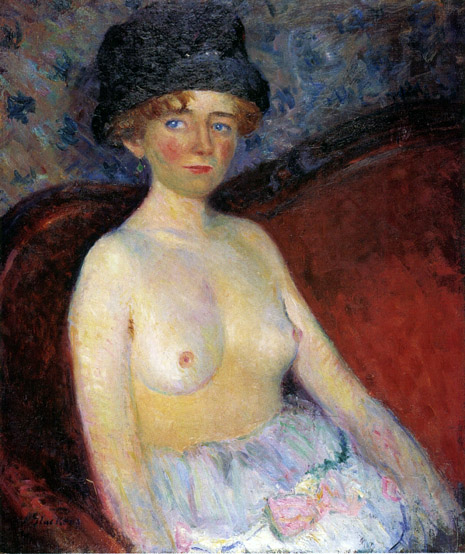
Nude with Hat: 1909
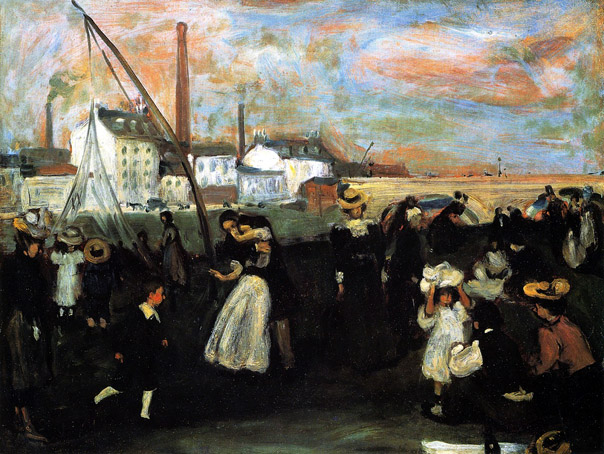
On the Quai: ca 1895-96
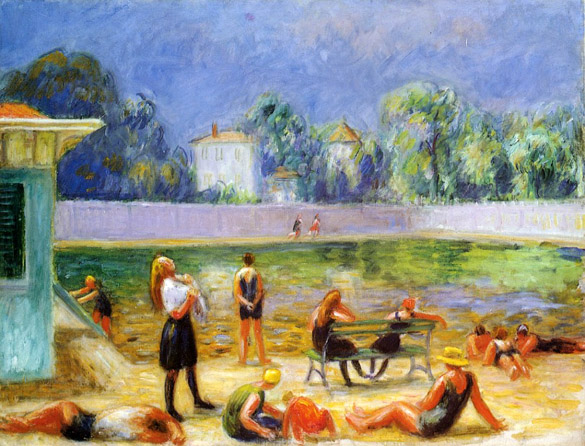
Outdoor Swimming Pool: Date Unknown
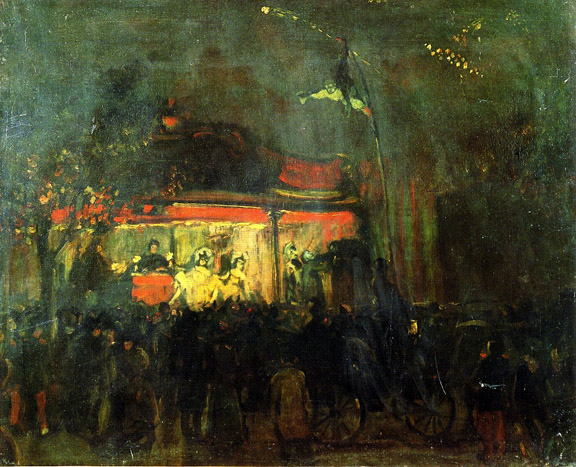
Outdoor Theater, Paris: ca 1895

Outside the Guttenberg Race Track: 1897

Parade, Washington Square: 1912
In the City: Urban Views 1900-1940

Park on the River: ca 1902
East River Park:
William Glackens found ample subject matter in the parks of New York and the city dwellers who frequented them. Here he depicted the natural features of the East River Park, and the pastimes of its inhabitants, in sharp contrast to the bustling industrial setting of Brooklyn's waterfront visible across the water. For the many immigrants living in small, cramped quarters, the urban parks of Brooklyn and Manhattan served as a refuge from the poor conditions and overcrowding of tenement life.
Quoted From: Brooklyn Museum: American Art - East River Park
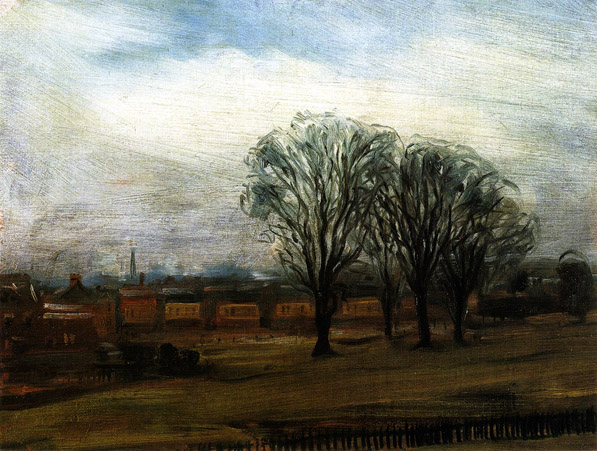
Philadelphia Landscape: 1893
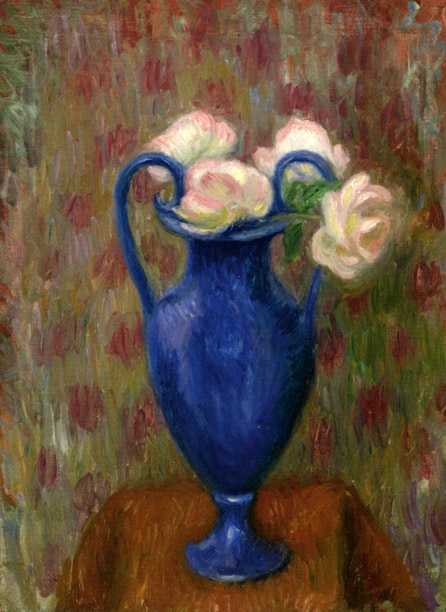
Pink Roses in Blue Urn: Date Unknown
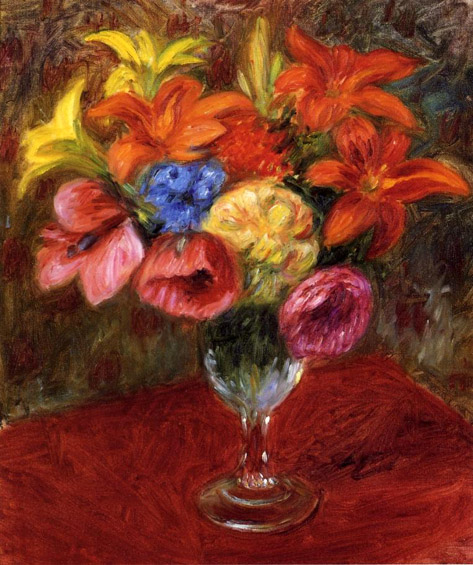
Poppies, Lilies and Blue Flowers: ca 1915
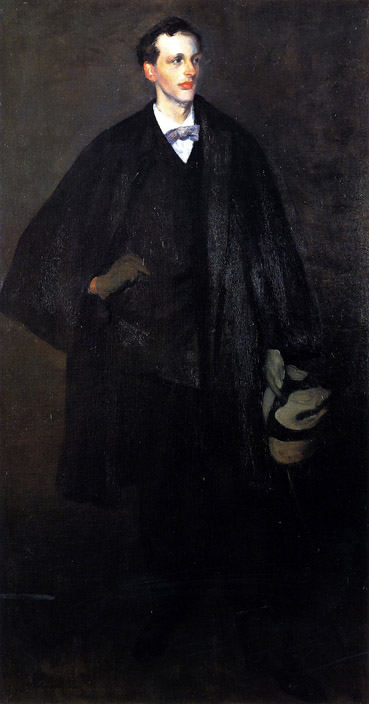
Portrait of Charles FitzGerald: 1903

Portsmouth Harbor, New Hampshire: 1909
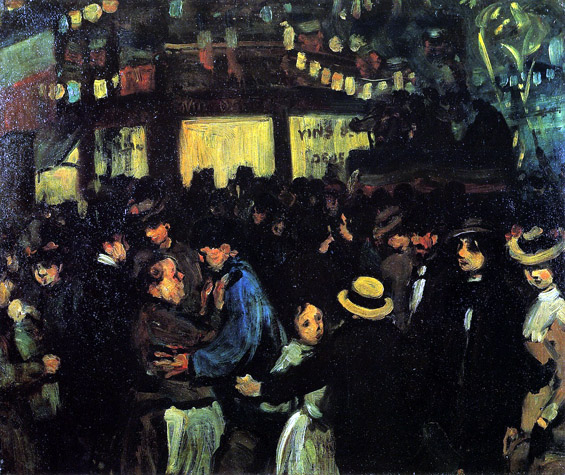
Quatorze Juillet: 1895-96
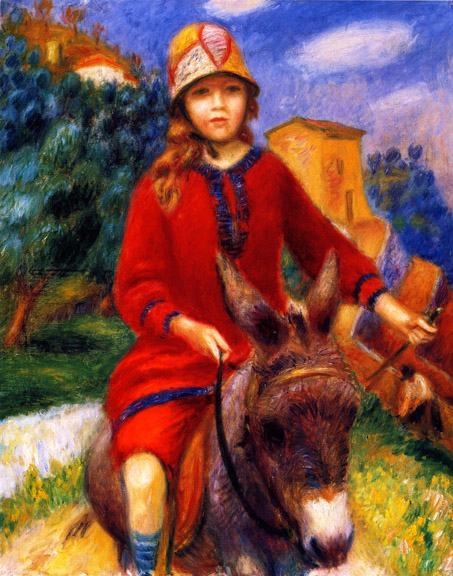
The Promenade: ca 1925-26
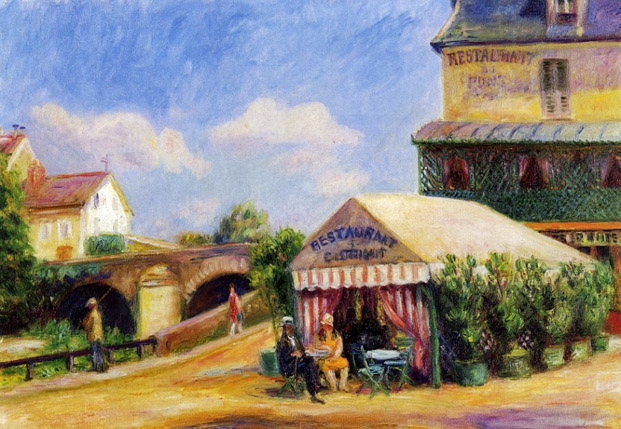
Restaurant du Pont: 1926
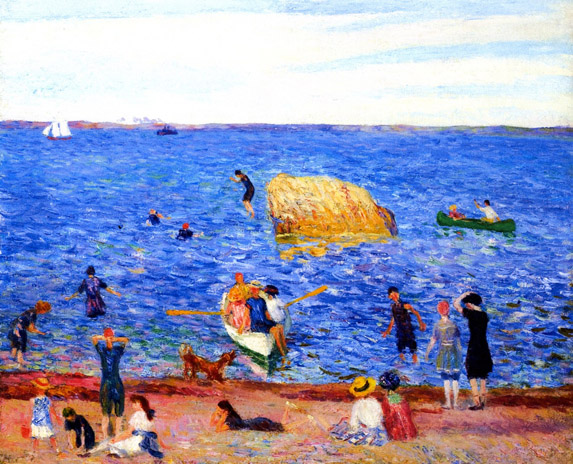
Rock in the Bay, Wickford: 1909
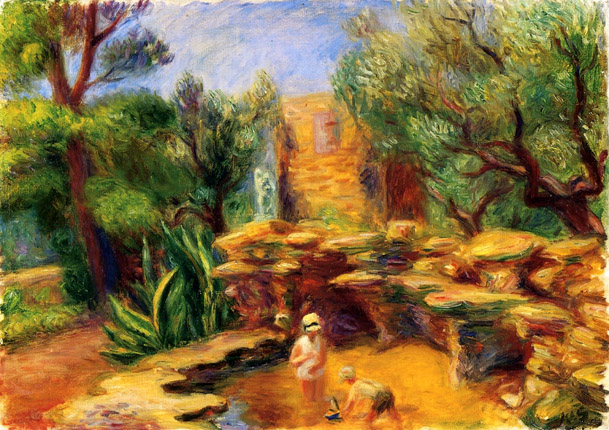
Rock Pool at Cytharis: 1930
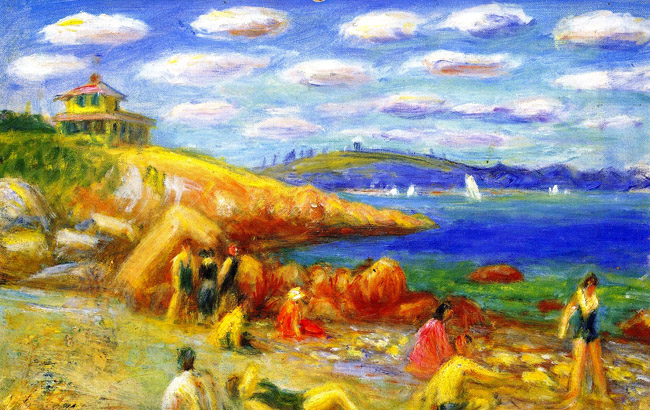
Rockport, Massachusetts, No. 5: 1936
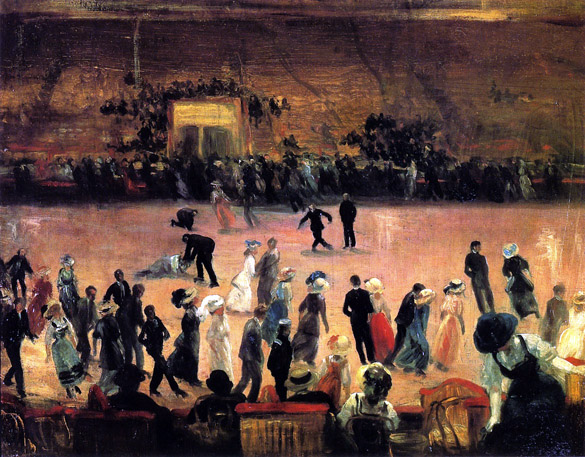
Roller Skating Rink: 1906
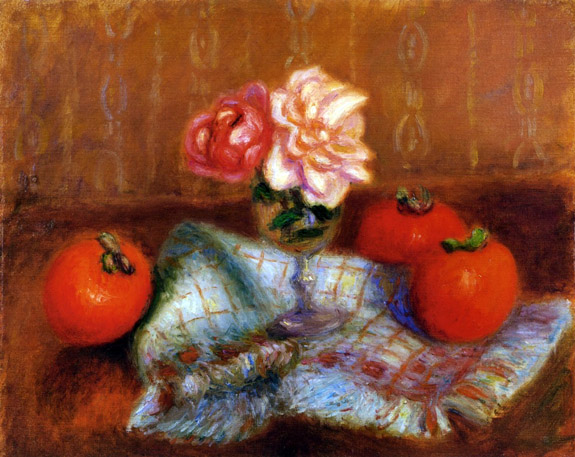
Roses and Perimmons: ca 1920
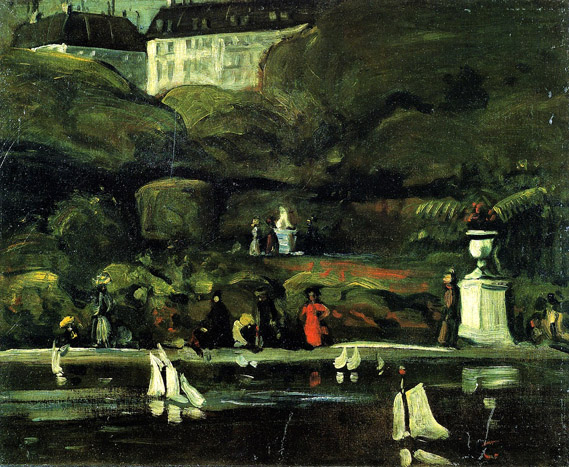
Sailboats, Luxembourg Gardens: ca 1895

Sailing Boats Paris: ca 1895
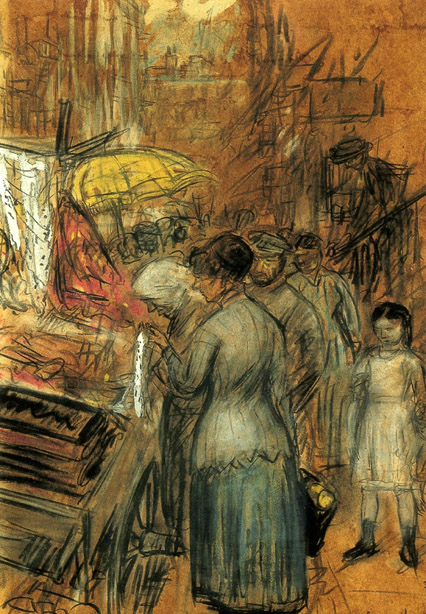
Scene on the Lower East Side: ca 1905-10
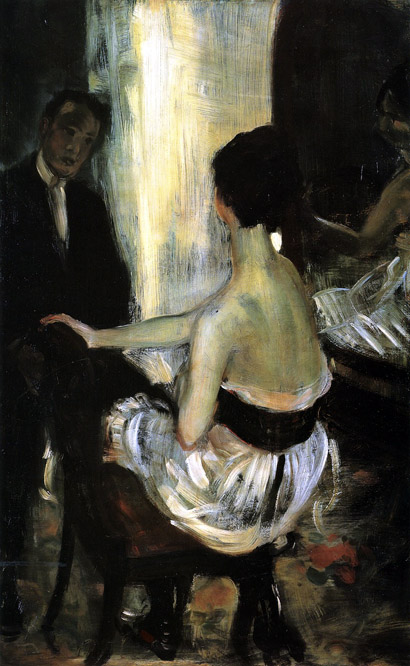
Seated Actress with Mirror: ca 1903
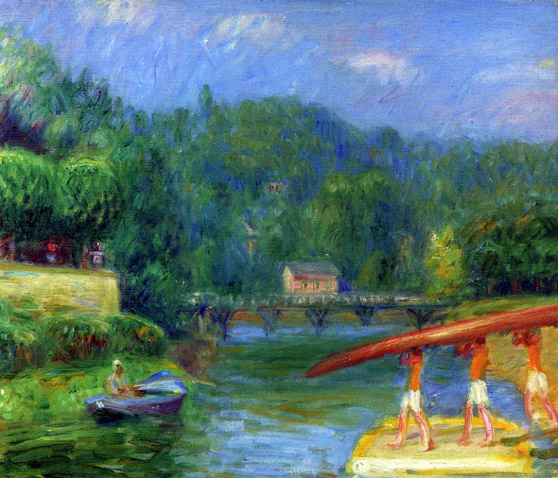
The Shell: ca 1926-27
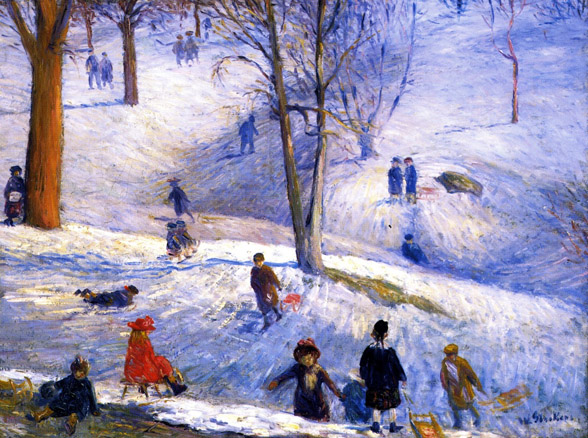
Sledding, Central Park: 1912
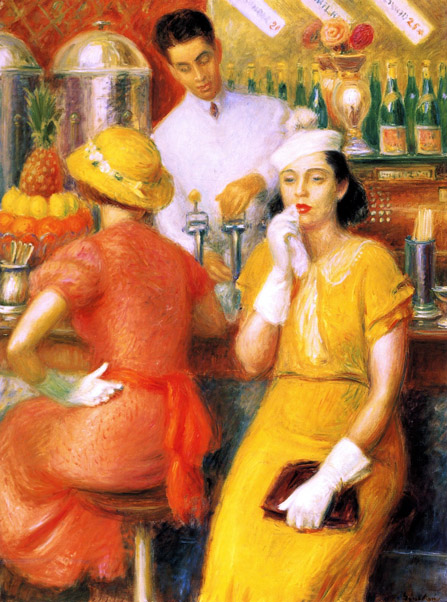
The Soda Fountain: 1935
In celebration of the debut of the Barnes Foundation in its new home on the Benjamin Franklin Parkway, PAFA welcomes its new neighbor by exploring the connections between the Pennsylvania Academy and Dr. Albert Barnes. This exhibition will feature works from the permanent collection that relate to Barnes's tastes and philosophy, as well as works by his friends (such as William J. Glackens), and items from the PAFA Archives.
It was at PAFA in April 1923 that Barnes first revealed the richness of his modern European art collection to the American public. Among the factors that led Barnes to allow 75 paintings and sculptures from his collection to be shown at PAFA was the presence of progressive faculty members such as Arthur B. Carles. Barnes had written to Carles in 1921 after viewing an avant-garde PAFA exhibition showing "Later Tendencies in Art" congratulating "the liberal spirit of the officials of the Academy in opening their doors to what is the most real and vital movement to many, many people interested in art…your present show is the first real move to shake Philadelphia out of the lethargy which has been the reproach to us from artists and collectors of other cities…It's a mighty fine thing for Philadelphia to have genuine artists of ability have the opportunity to express themselves freely and without dictation from self-constituted authorities or conventional dogma and have those expressions viewed by the public for what they are worth. It is a positive step towards education and enlightenment in the proper meanings of those words."
Two years later, he would revise his opinion about Philadelphia, rather than PAFA, in the wake of criticism of his collection. This installation will include material related to the 1923 exhibition and present works that show links between PAFA and Barnes.
Quoted From: Pennsylvania Academy of the Fine Arts - Museum and School
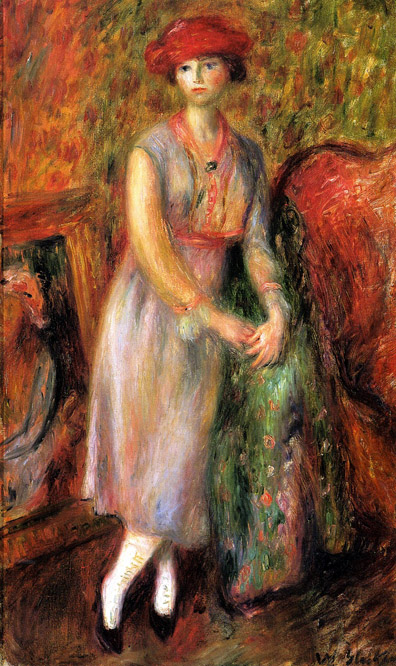
Standing Girl in White Spats: 1915
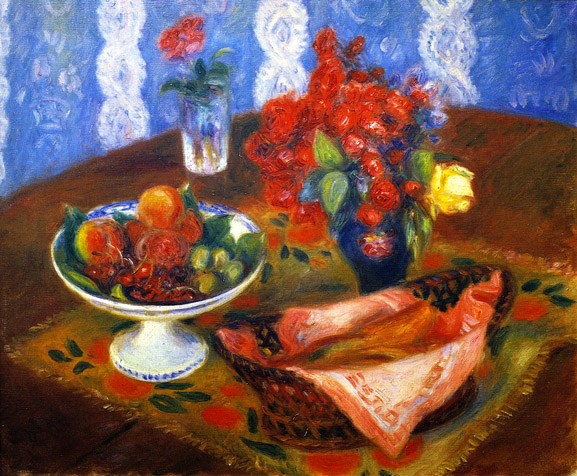
Still Life with Roses and Fruit: ca 1924
Painted during William Glackens's later period, Still Life with Roses and Fruit skillfully combines the influence of Renoir's feathery brushstrokes and rosy palette with Matisse's shifting perspectives. Glackens's lovely arrangement of flowers and fruit is typical of what might be called the twentieth-century attitude in still life. The objects on the table are of less interest to the artist than the relationship between the different colors and patterns that describe them. Cool blues and browns are continually juxtaposed with warm reds, pinks and yellows. All of these contrasts help to create the luminous intensity of the painting and its compelling character, which extends far beyond simple decorative value.
Quoted From: The High Museum of Atlanta
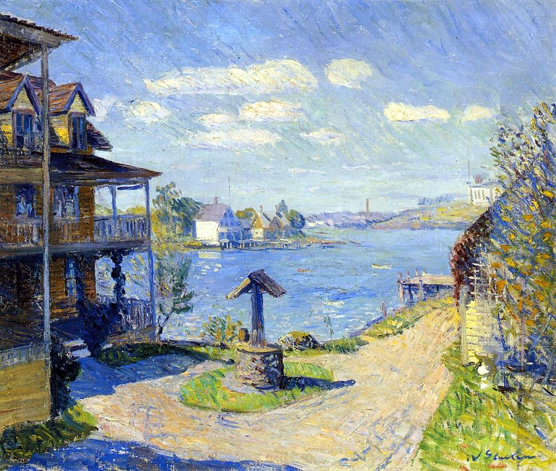
Summer Hotel: 1909
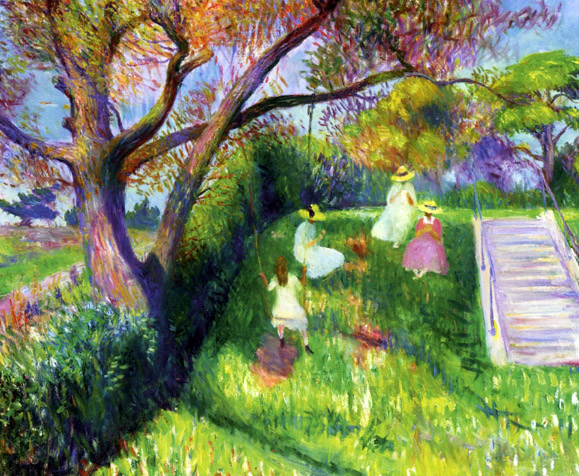
The Swing: 1913

Town of Venice: ca 1925-26
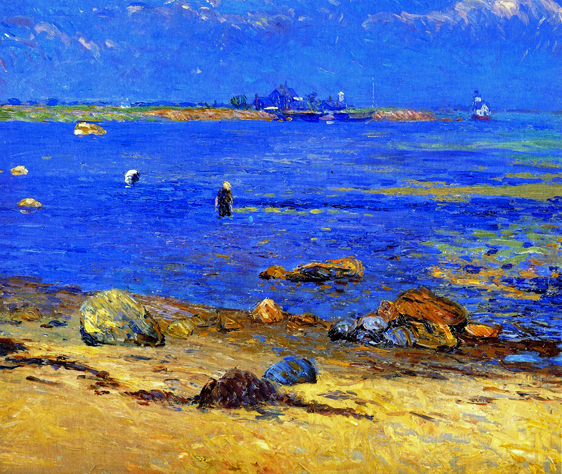
Treading Calms, Wickford: 1909
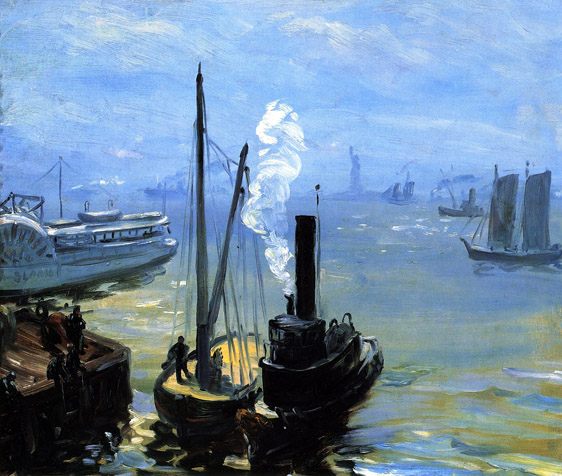
Tugboat and LIghter: 1904-05
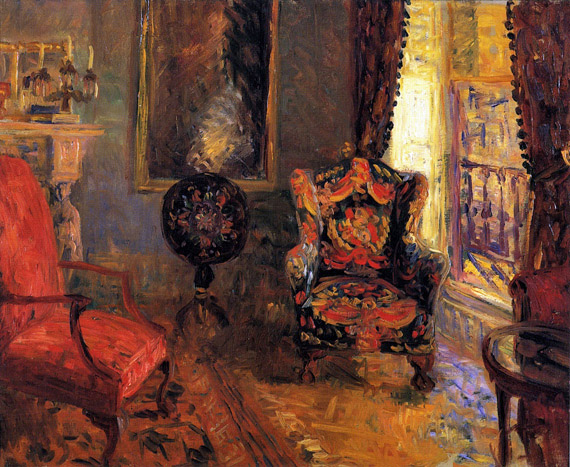
Twenty Three Fifth Avenue: ca 1910
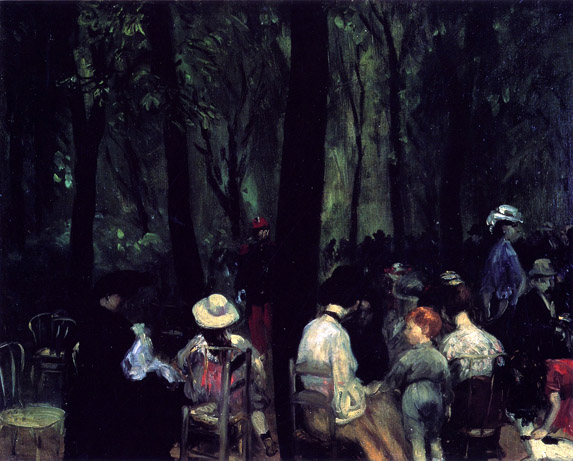
Under the Trees, Luxembourg Gardens: 1906
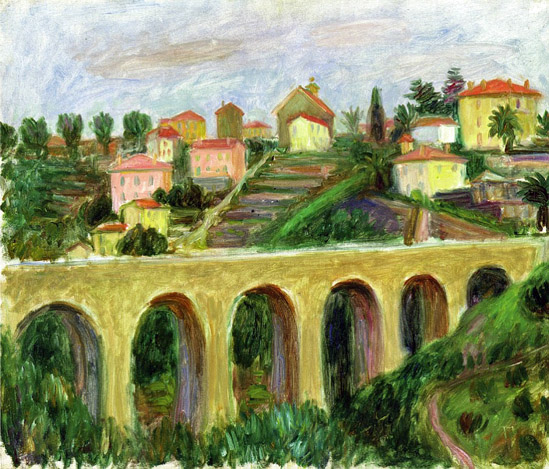
Viaduct at Venice: ca 1926
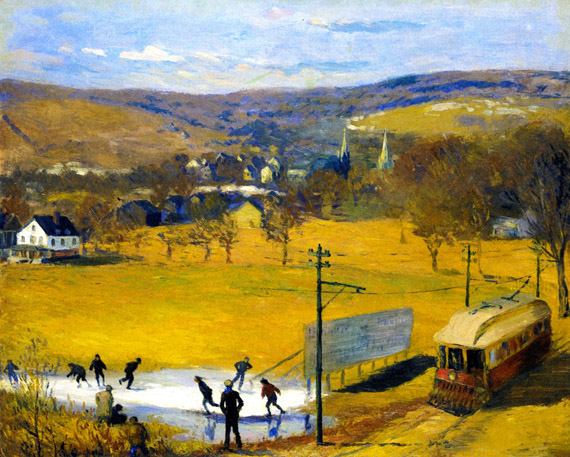
View of West Hartford: 1907
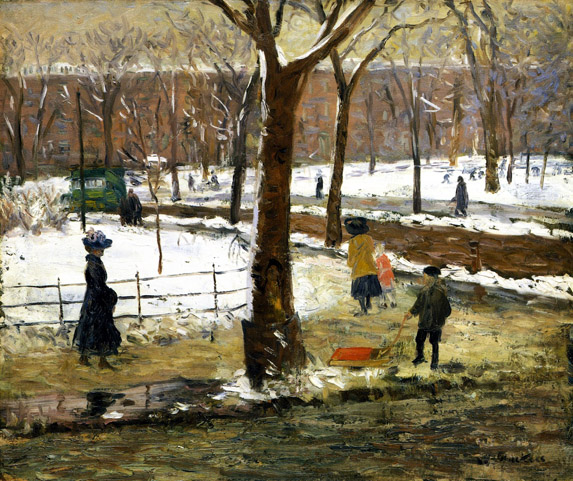
Washington Square, Winter: ca 1910
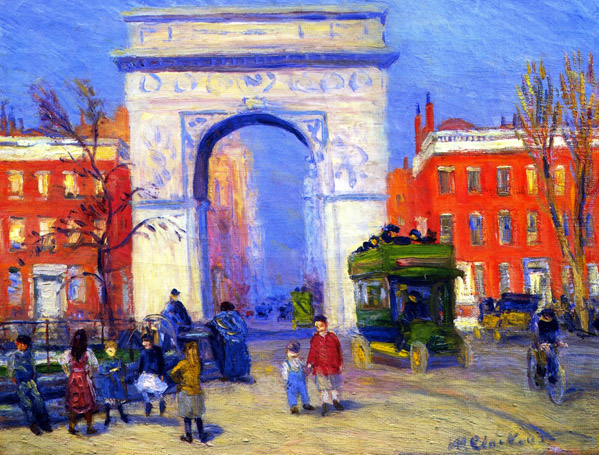
Washington Square: ca 1911
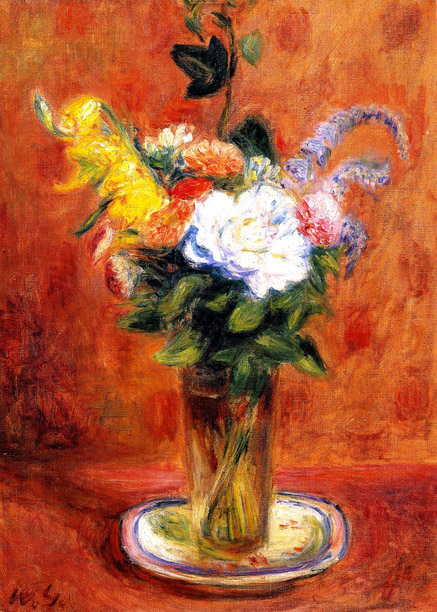
White Rose and Other Flowers: 1937
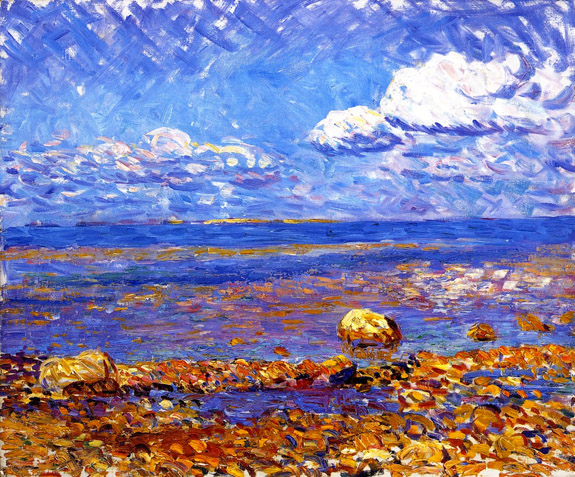
Wickford Low Tide: ca 1908
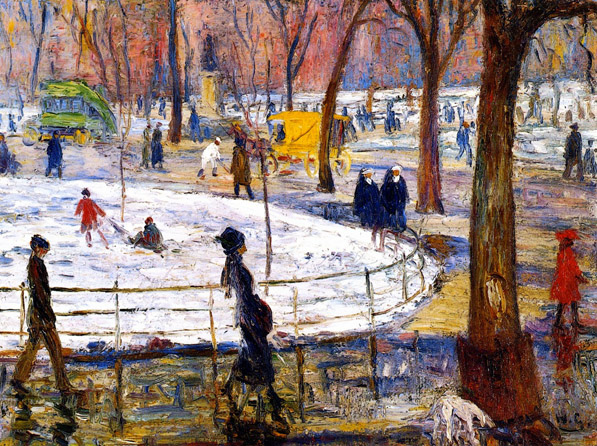
Winter, Washington Square Park: ca 1912
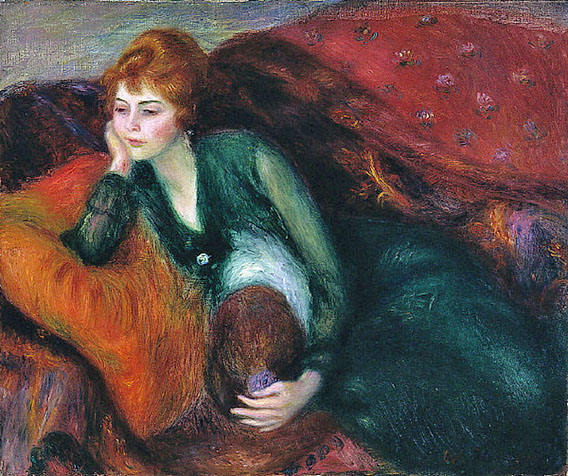
Young Woman in Green: ca 1915
In this work, William J. Glackens juxtaposes dark green and bright orange, employing both hues to render the skin tone of his model. Late in his career, Glackens favored light colors and feathery brushwork reminiscent of the paintings of French Impressionist Pierre Auguste Renoir. The soft brushstrokes seem well suited to the plush cushion, downy blanket, and hat plume, as well as to the dreamy mood of the model.
Quoted From: Saint Louis Art Museum - eMuseum
Related Source Material
William James Glackens - The Athenaeum
William Glackens Online
This page is the work of Senex Magister
Return to Pagina Artis
Return to Bruce and Bobbie's Main Page.

























_1934.jpg)

_1926.jpg)













_ca_1916.jpg)








_1906.jpg)
























_1906.jpg)





































_ca_1918.jpg)



_Date_Unknown.jpg)













































